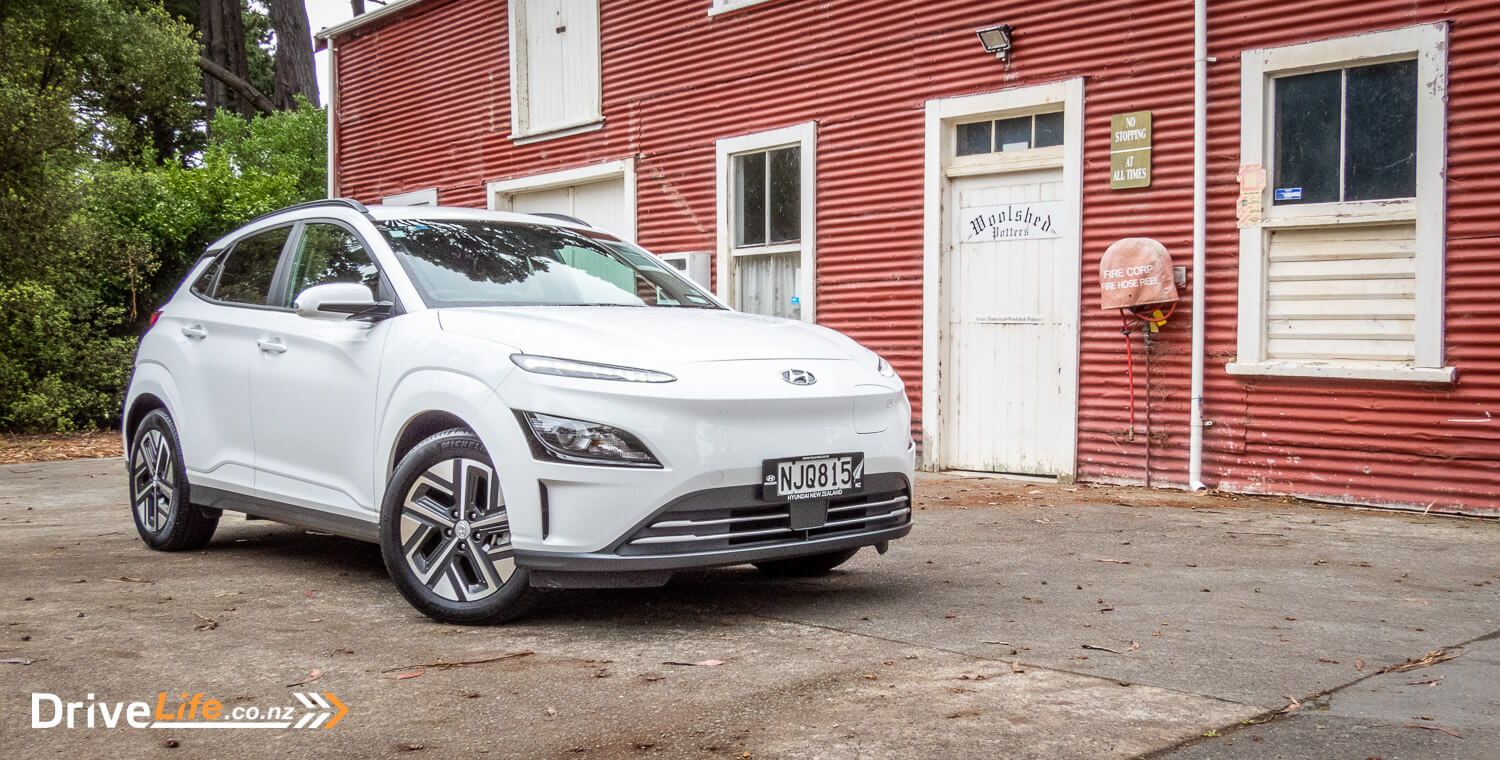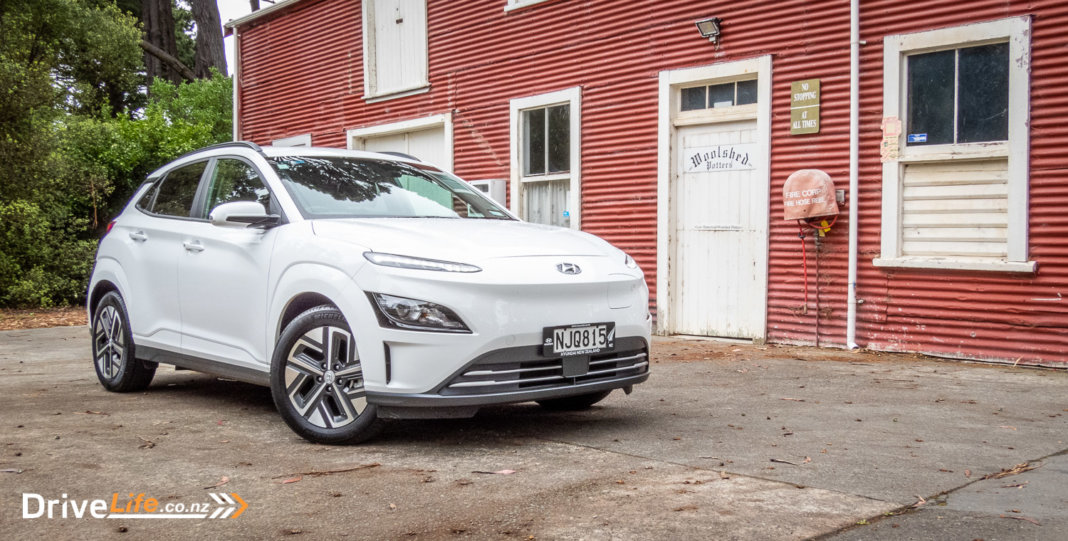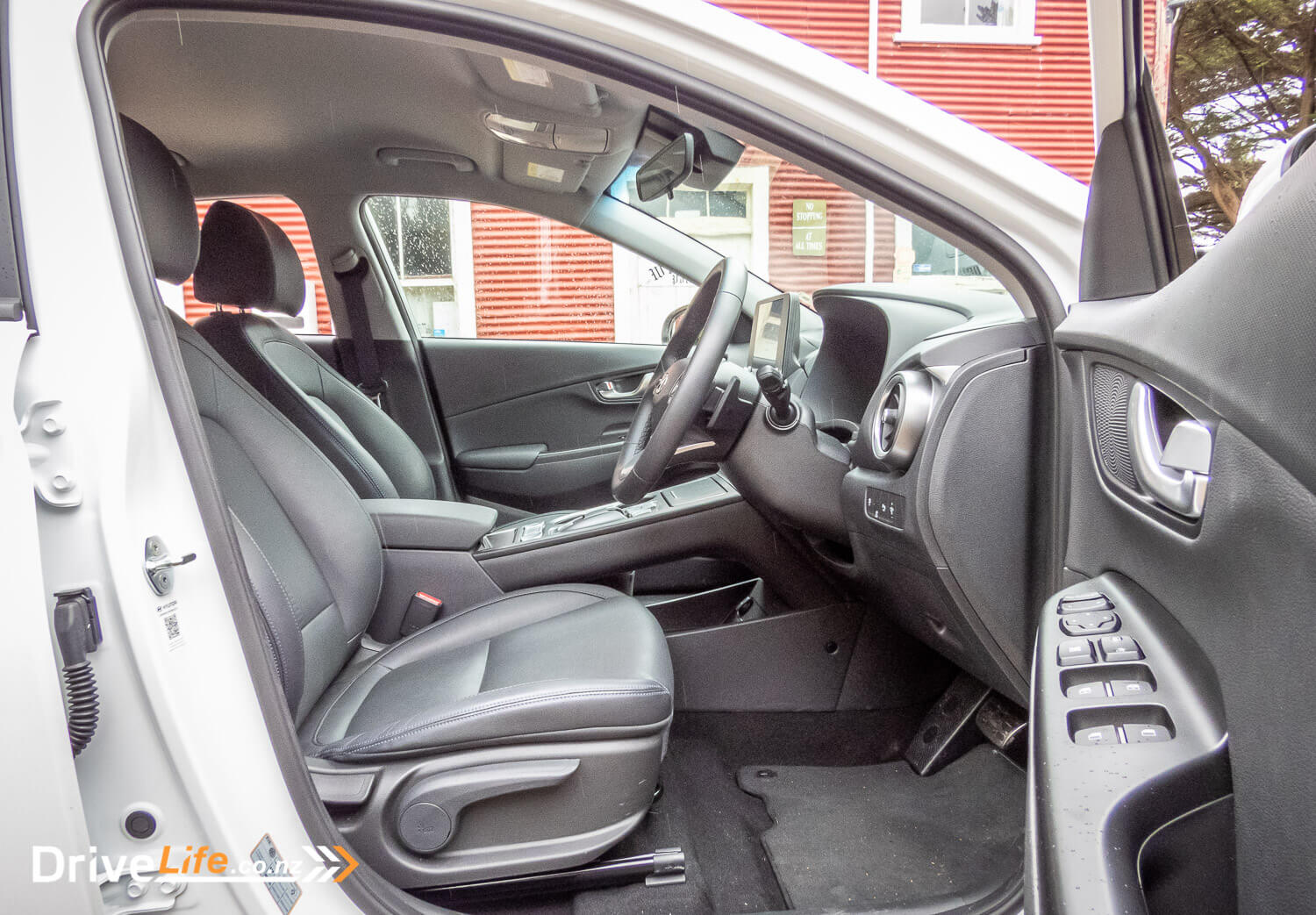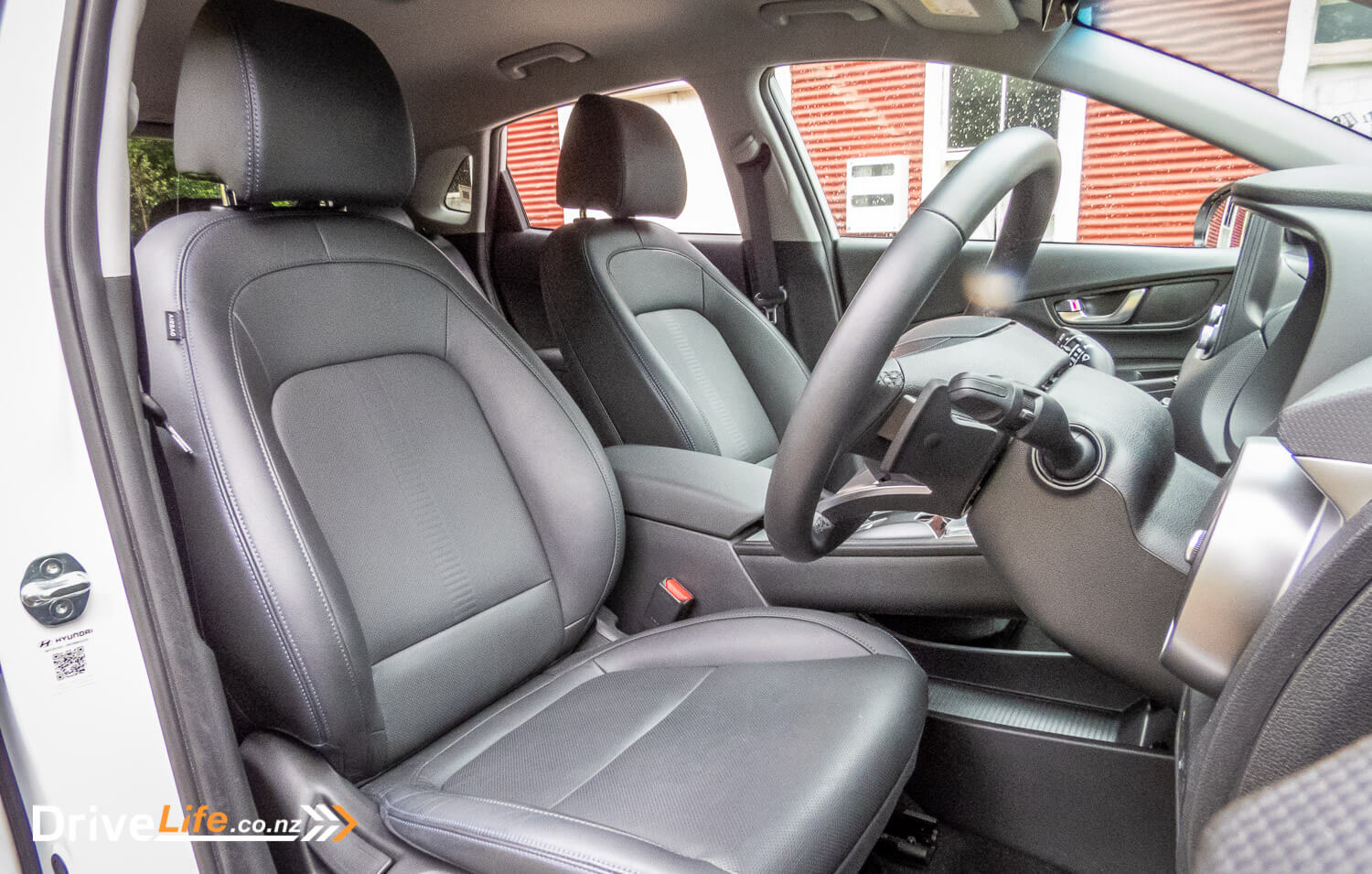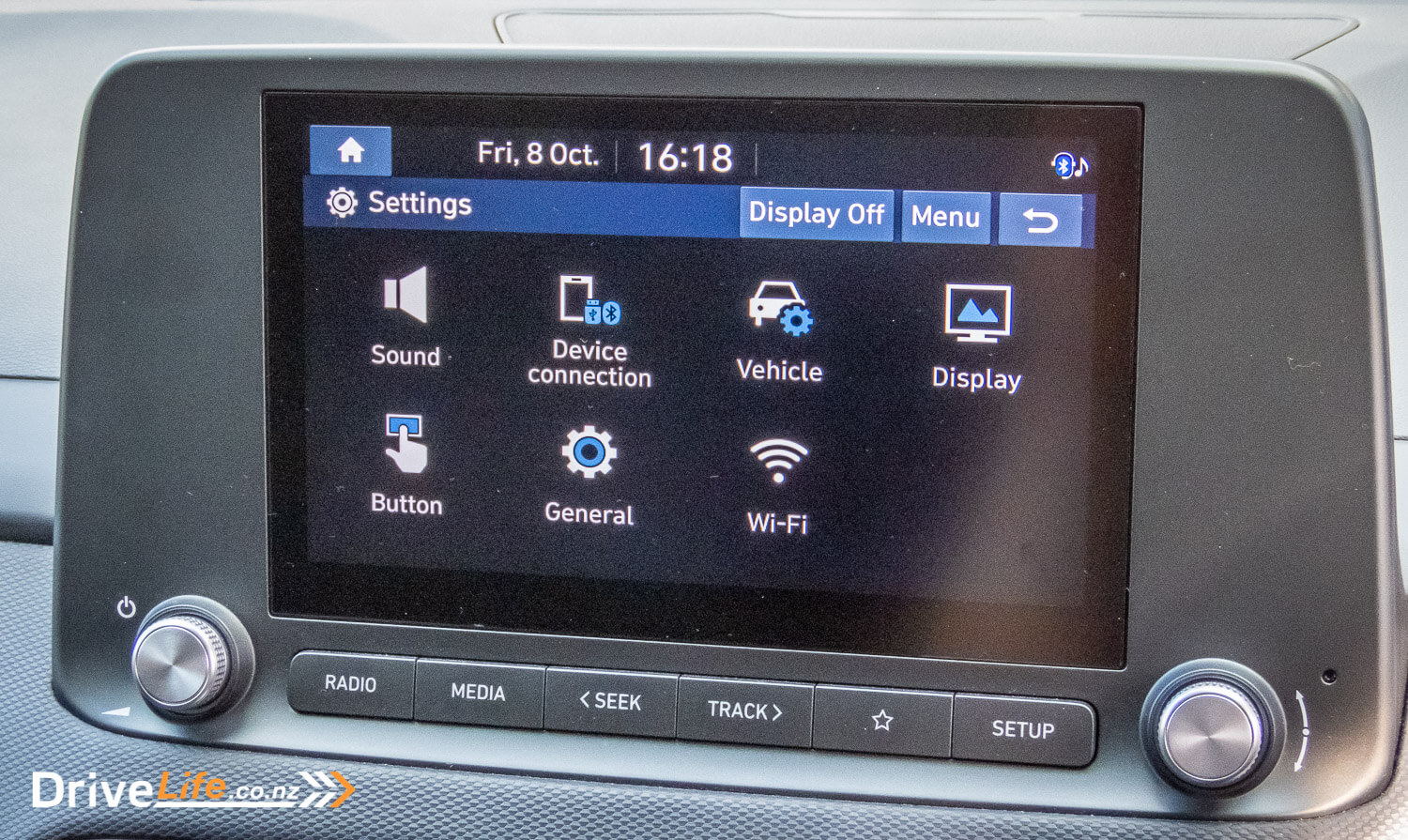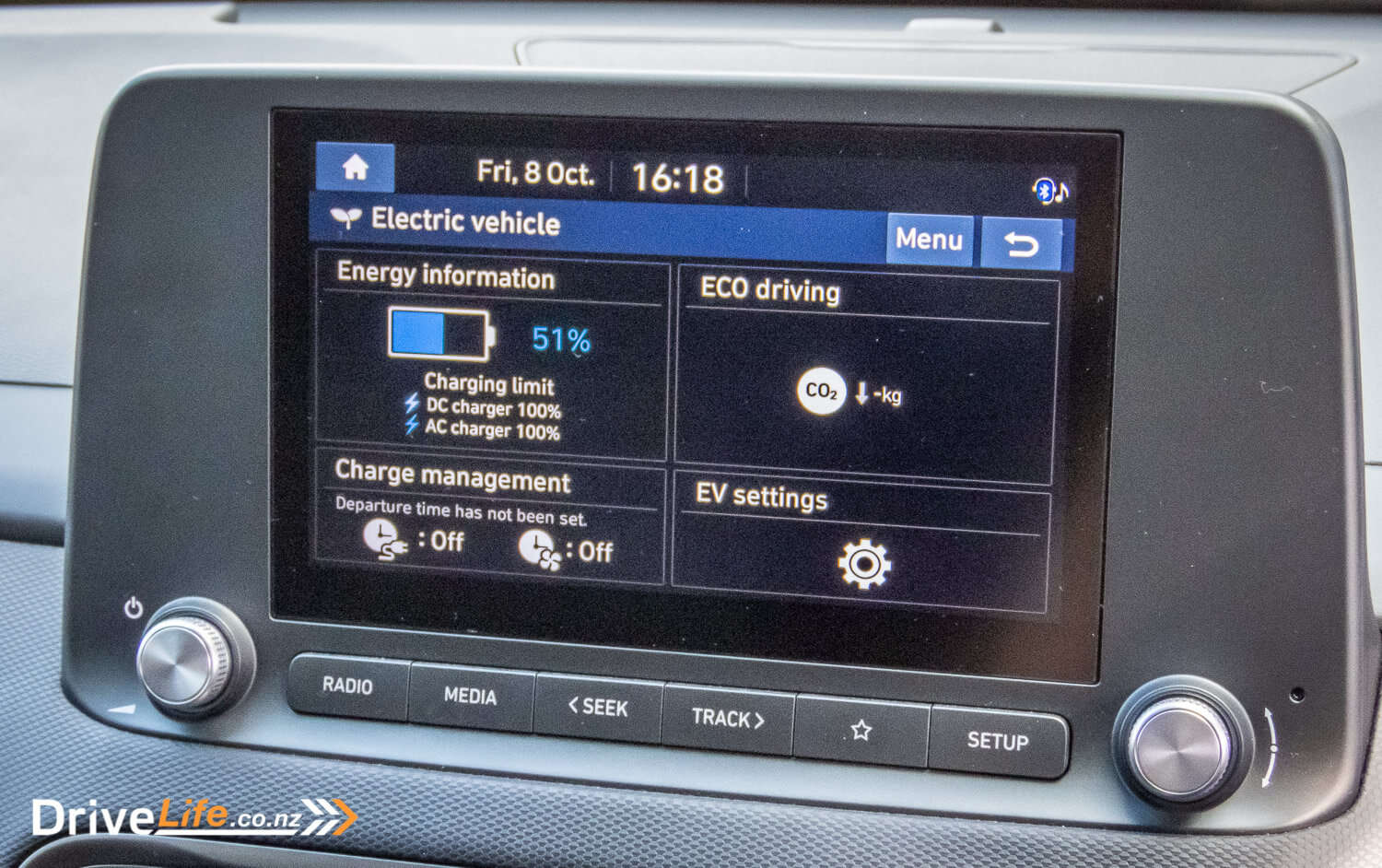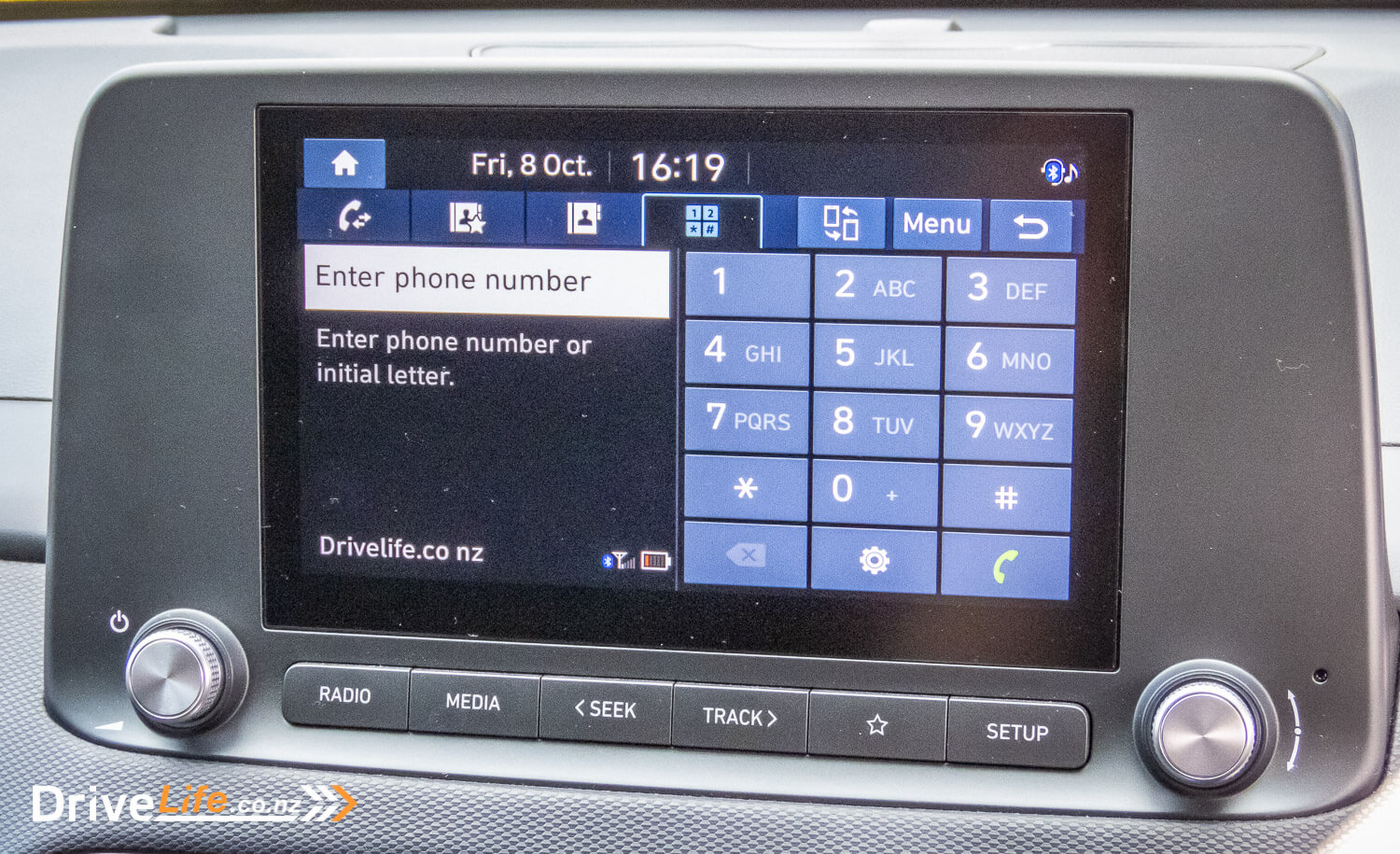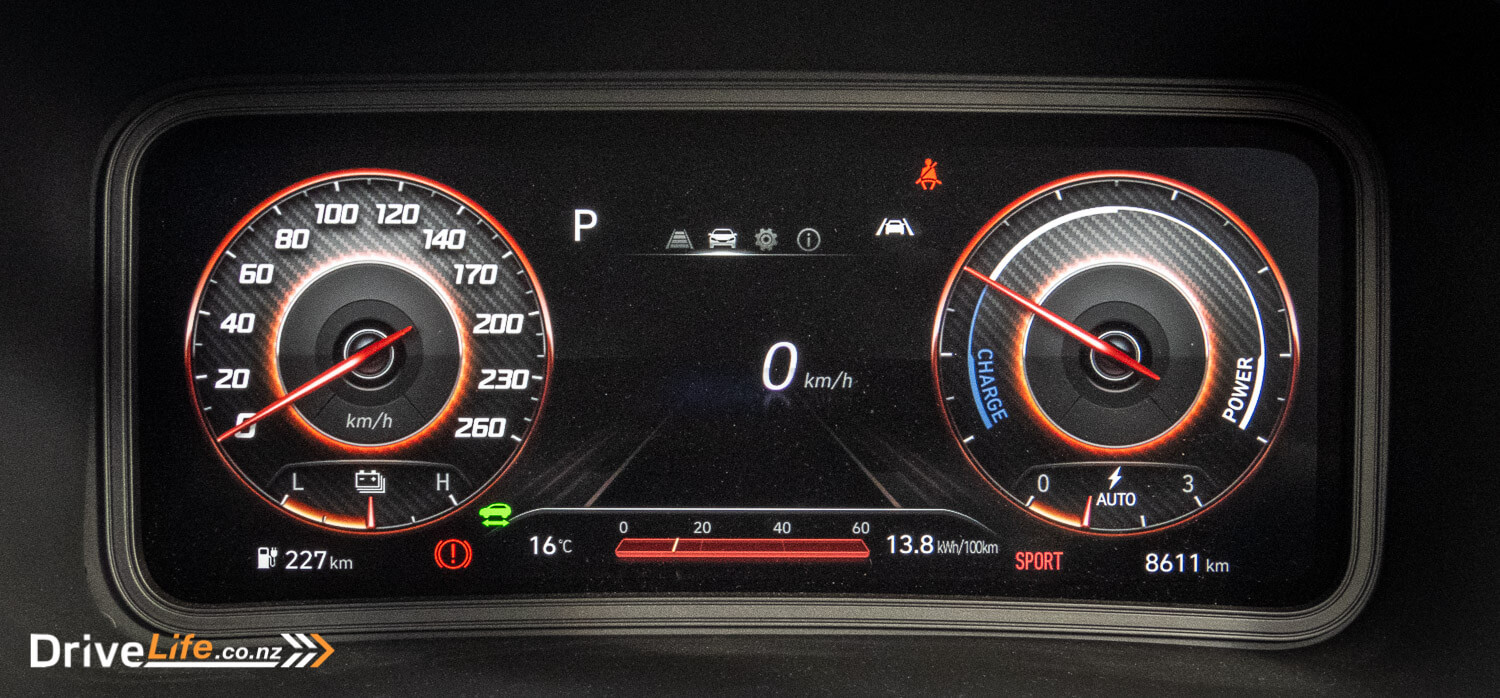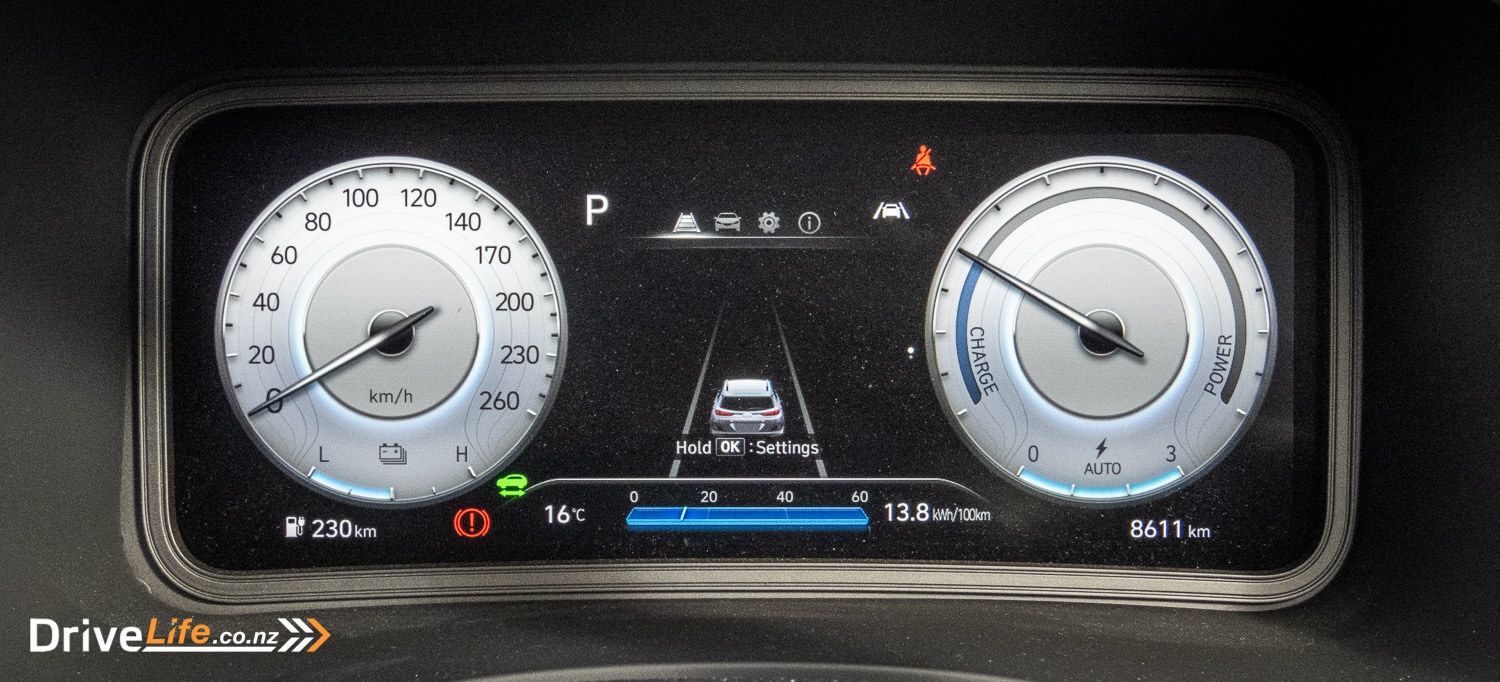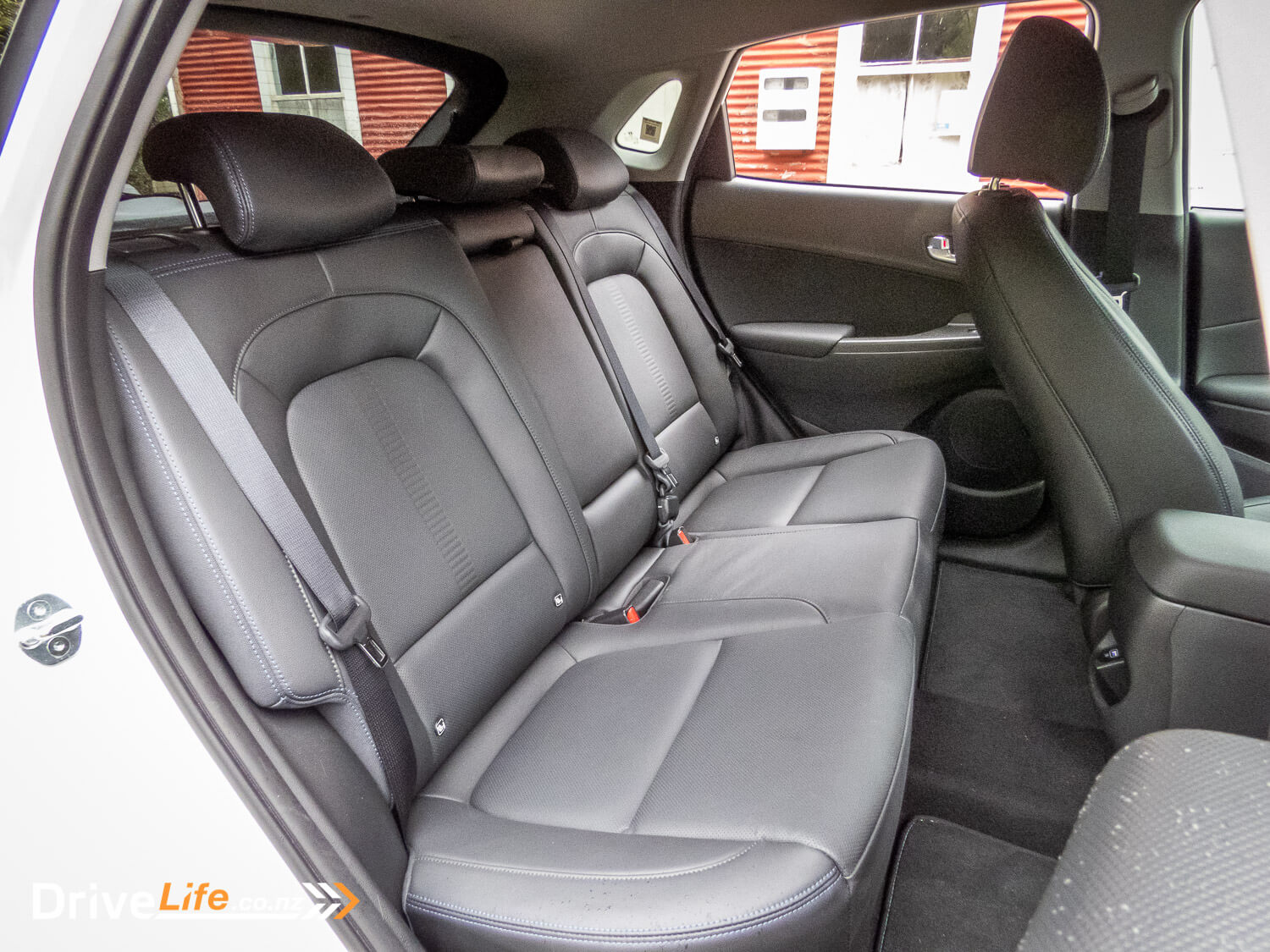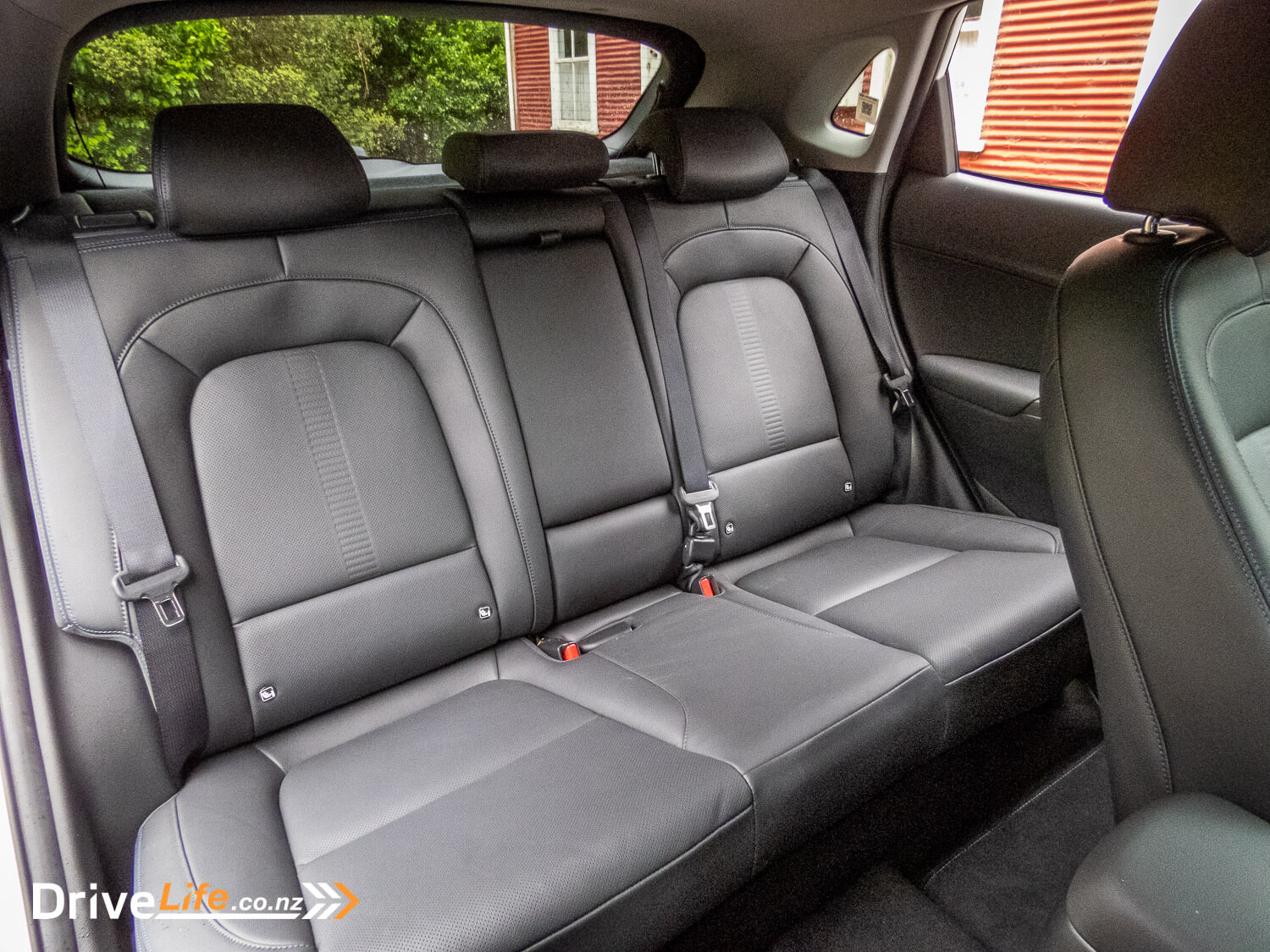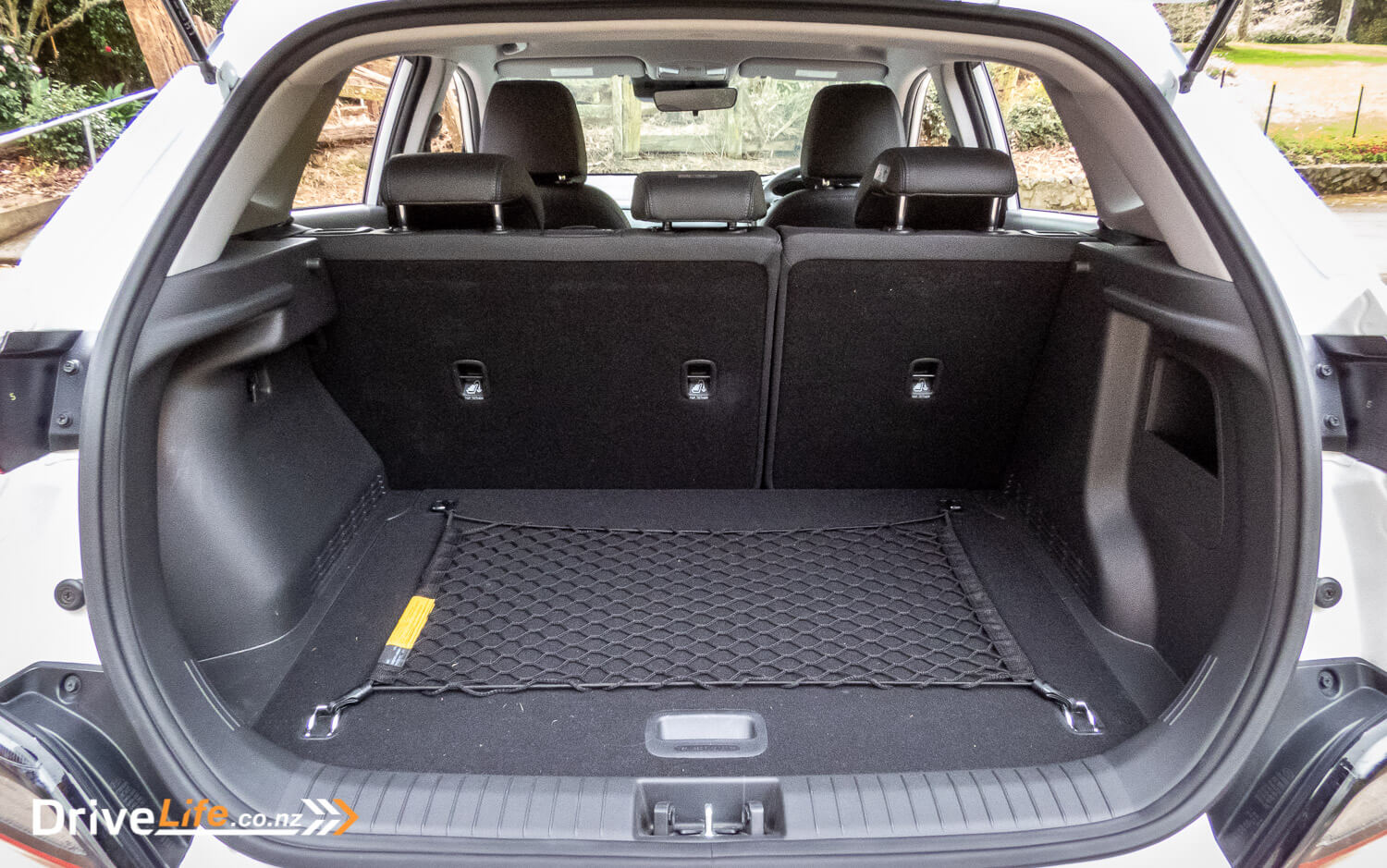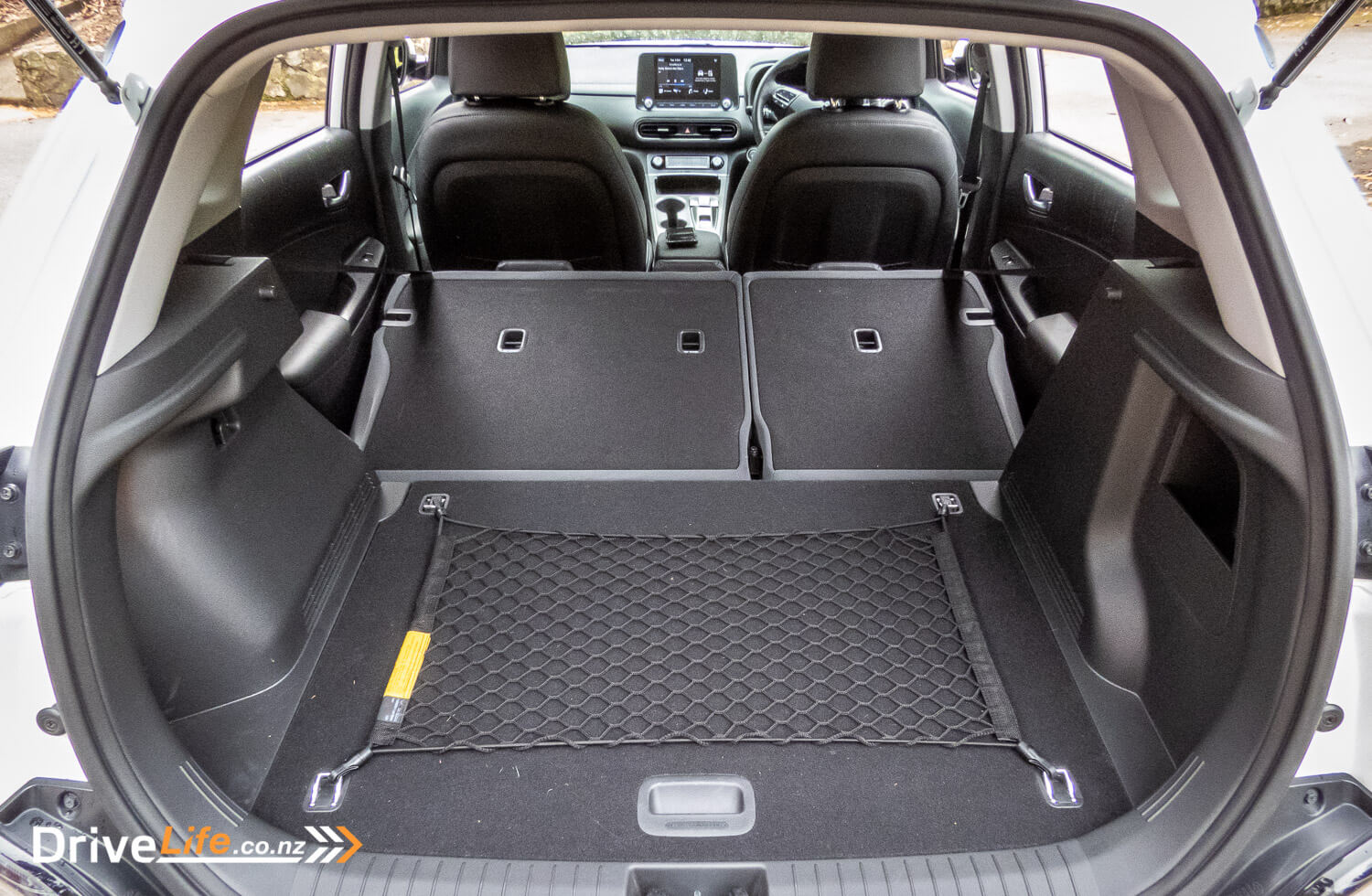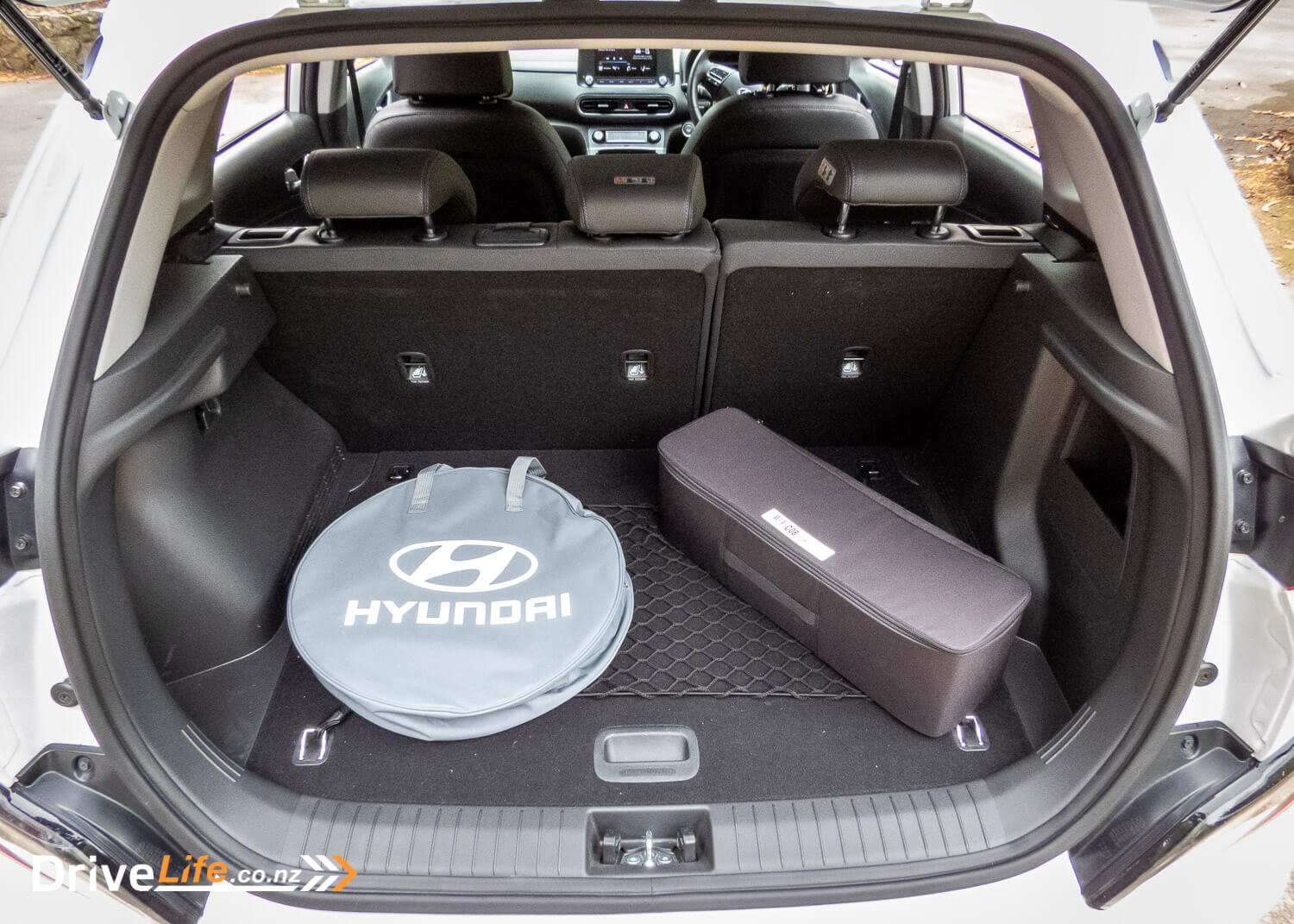As we blaze towards the end of 2021, competition within the EV market is beginning to heat up. The transition towards EV’s by manufacturers globally has seen the introduction of many more electrified models, many of which are now starting to show-up on New Zealand’s shores.
We can confirm this as reviewers, based on the record number of EV’s we’ve tested this year. But also, our readers might have noticed a shift in New Zealand’s vehicle landscape. These days, I can’t seem to leave the house without spotting a Tesla Model 3 or Nissan Leaf.
Even though New Zealand’s EV population is still relatively skewed towards these two, the arrival of fresh competition, such as Peugeot’s stylish 208 EV, the budget friendly MG ZS EV, Audi’s blistering E-Tron GT, or Mazda’s unique MX-30, means that simply being an EV no longer cuts the mustard.
Enter the Hyundai Kona EV. The Kona EV has been around for a few years now, and it’s kept a relatively low profile. Sure, the Kona EV II mightn’t have the allure of Hyundai’s latest Ioniq 5, nor the hype of any Tesla product, but it has historically been a solid choice.
So, in the face of fresh competition, what does the Kona EV Series II offer over competitors? Hyundai gave us the keys to find out.
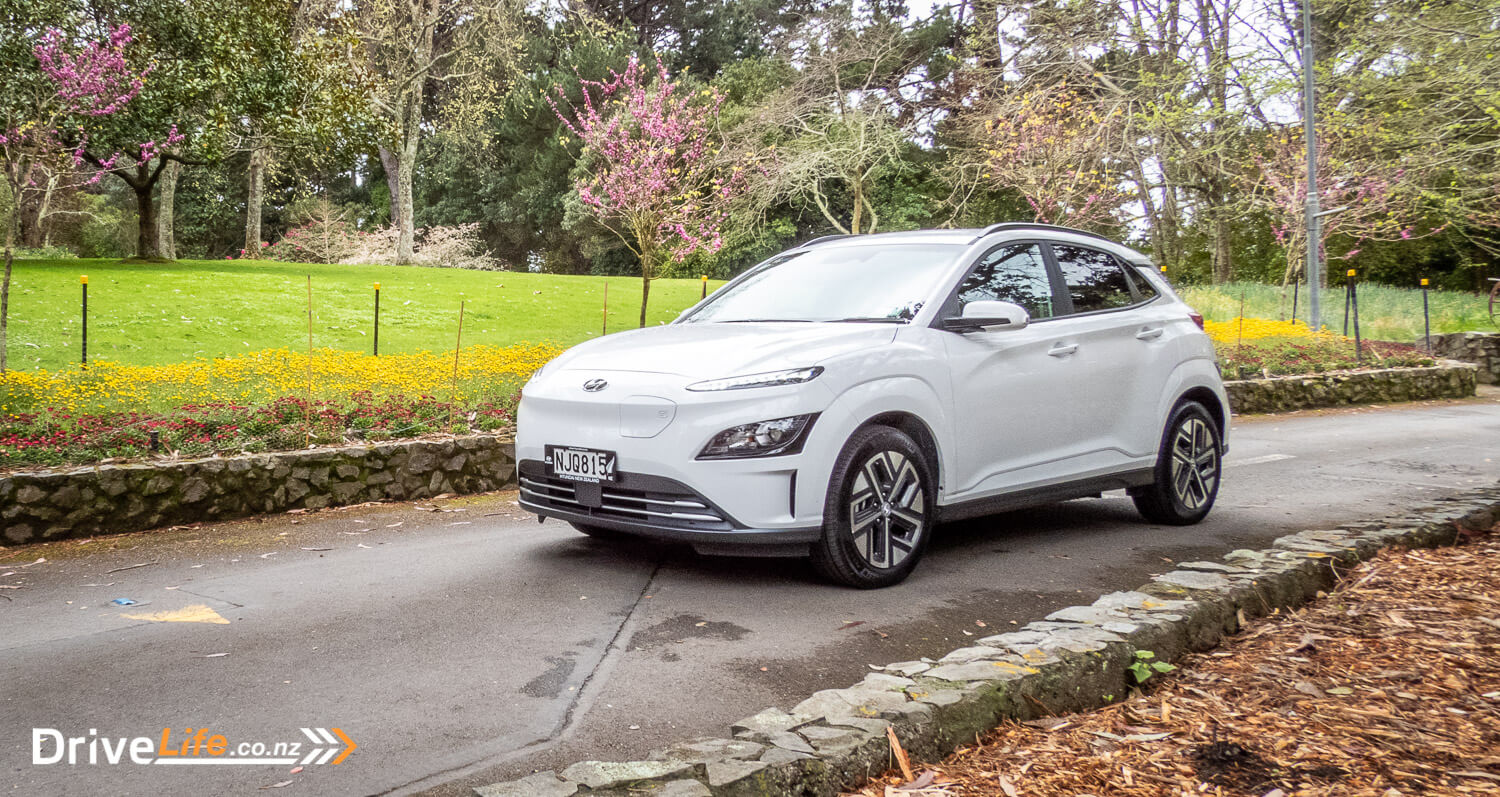
What We Like and Dislike About The 2021 Hyundai Kona EV
| What we like | What we don’t like |
| Excellent energy efficiency Range Ride quality Interior ergonomics Competent driver assistance suite | Price Polarising looks Level of standard equipment on the base model Cramped rear passenger space |
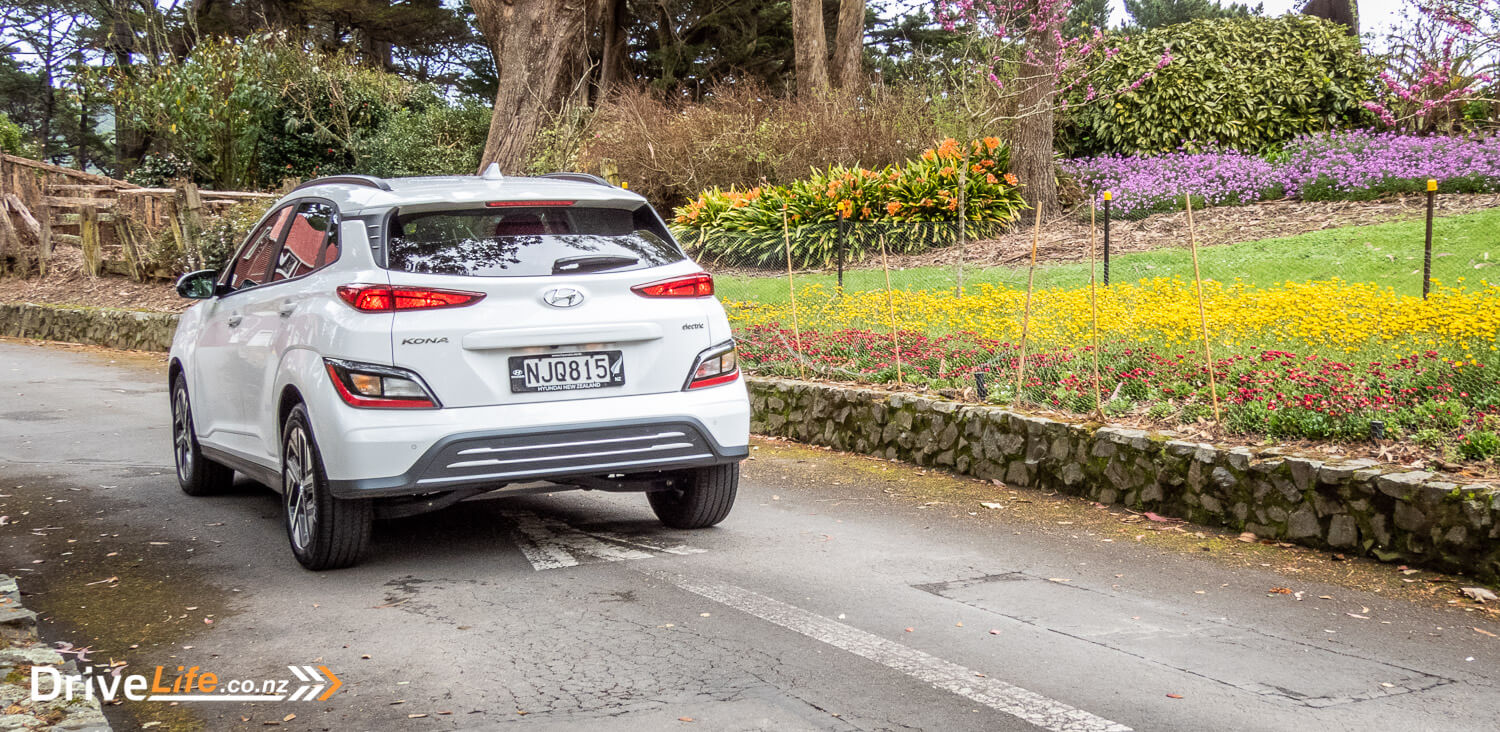
What’s In The 2021 Hyundai Kona EV Range?
The Kona EV Series II is offered in four trim levels, offering two choices of interior spec and two powertrain options.
Each Kona EV model is priced below*
| Model | Starting Price* |
| Kona Electric 39 kWh Series II | $69,990 |
| Kona Electric Elite 39 kWh Series II | $76,990 |
| Kona Electric 64 kWh Series II | $79,990 |
| Kona Electric Elite 64 kWh Series II | $87,990 |
Starting the range is the 39kWh Kona EV, which is effectively the short-range model. This model produces 100kW of power and 395Nm of torque, and offers a driving range of 305km WLTP. Upgrading to the 64kWh Kona EV gives power a healthy 50kW bump, producing 150kW of power and 395Nm of torque.
Most significantly, the driving range climbs to 484km WLTP – which is enough extra distance to travel from downtown Auckland to Coromandel. Alternatively, it’s enough distance to get from Auckland to Hamilton, and you’ll also have 50kms extra left, to ensure that you can also swiftly leave.
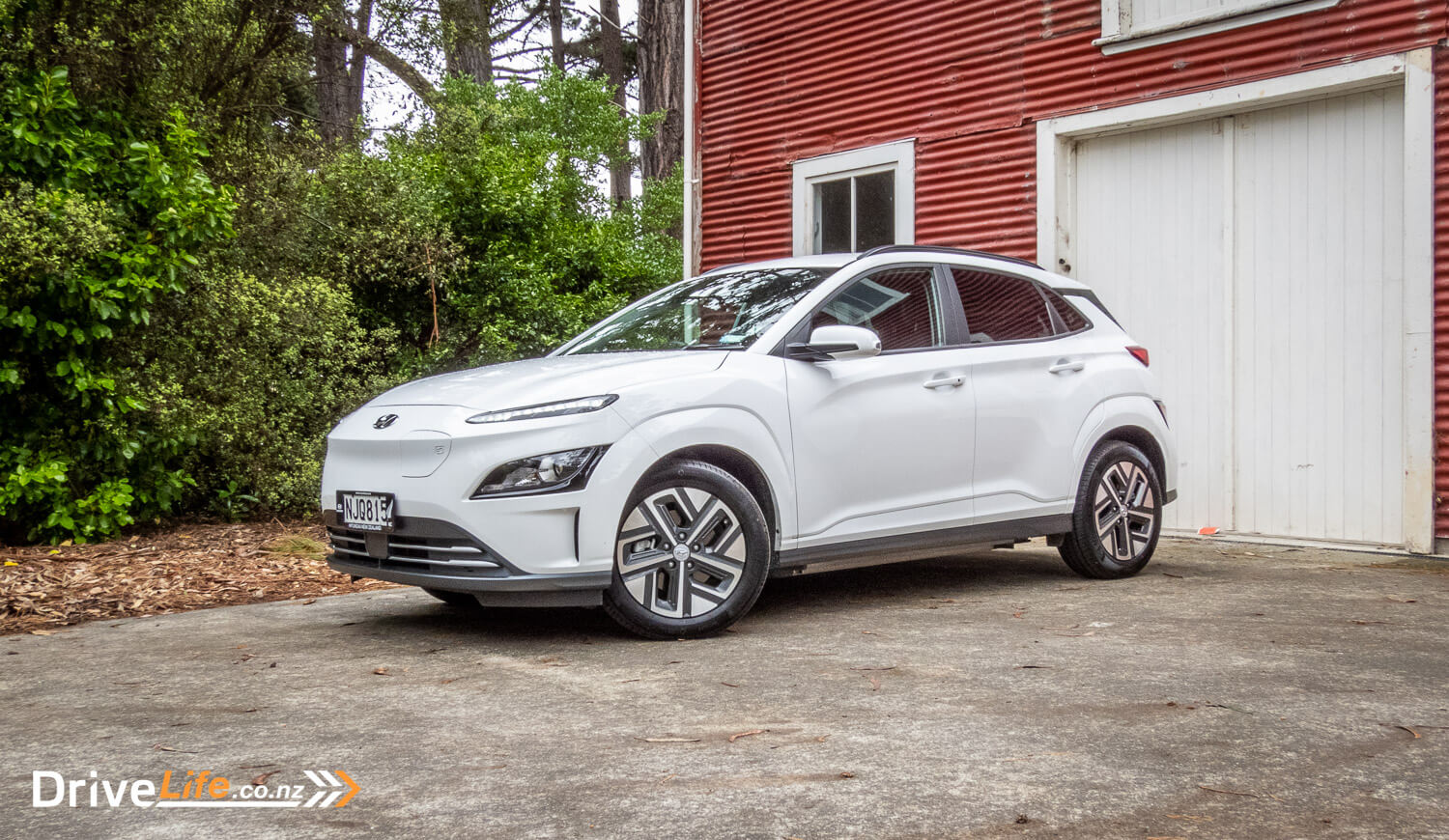
2021 Hyundai Kona EV Standard Equipment Highlights
- The entry-level Kona offers the following features as standard:
- 8″ touch screen infotainment with Bluetooth
- Apple Carplay and Android Auto
- 6 Speaker Sound System
- 10.25’’ digital drivers display
- Leather Seats
- Leather Steering wheel
- Electric folding side mirrors
- Heated side mirrors
- LED Daytime Running Lights (DRL)
- Privacy glass
- 3 USB inputs
- Proximity key with engine start / stop button
- Keyless entry
- Illuminated vanity mirrors
In addition to the above, upgrading to the Kona EV Elite adds on a litany of toys, including:
- 10.25″ touch screen infotainment
- Satellite navigation
- Harman Kardon premium audio system with 8 speakers including subwoofer
- 8-way adjustable power drivers’ seat, including sliding, reclining, height and lumbar support
- 6-way adjustable power drivers’ seat, including sliding, reclining, and lumbar support.
- Heated and ventilated front seats
- Heated rear seats
- Heated steering wheel
- Wireless smartphone charging
- Heads-Up Display
- LED headlights
- LED tail lights
- ElectroChromatic rear-view Mirror
The Kona EV range also comes with a full-suite of safety technology as standard, this includes:
- Brake Assist System (BAS)
- Electronic Stability Control (ESC)
- Traction Control System (TCS)
- Vehicle Stability Management (VSM)
- Blind-spot Collision Avoidance assist (BCA)
- Rear Cross-traffic Collision Avoidance assist (RCCA)
- Forward Collision-Avoidance Assist (FCA) with cyclist & pedestrian detection
- Adaptive Cruise Control (SCC) with stop & go
- Lane Keeping Assist (LKA)
- Front seatbelt pretensioners and load limiters
- 3-point tether child seat anchor points
- 2 x ISOFIX child seat anchor points
- Automatic dusk sensing headlights
- Rain sensing wiper system
- Rear Park assist system
The Elite models further add High Beam Assistance and front parking sensors.
The Kona EV has 10 different colour options, including:
- Atlas White (as seen on our review car),
- Dark Knight (grey – not Batman Black),
- Dive in Jeju (teal), Surfy Blue (light blue),
- Misty Jungle (blue-grey),
- Galactic Grey (deep grey),
- Ignite Flame (bright-red),
- Pulse Red (rich-red),
- Phantom Black,
- Cyber Grey (lighter grey).
You can read more about the Kona EV on Hyundai New Zealand’s website.
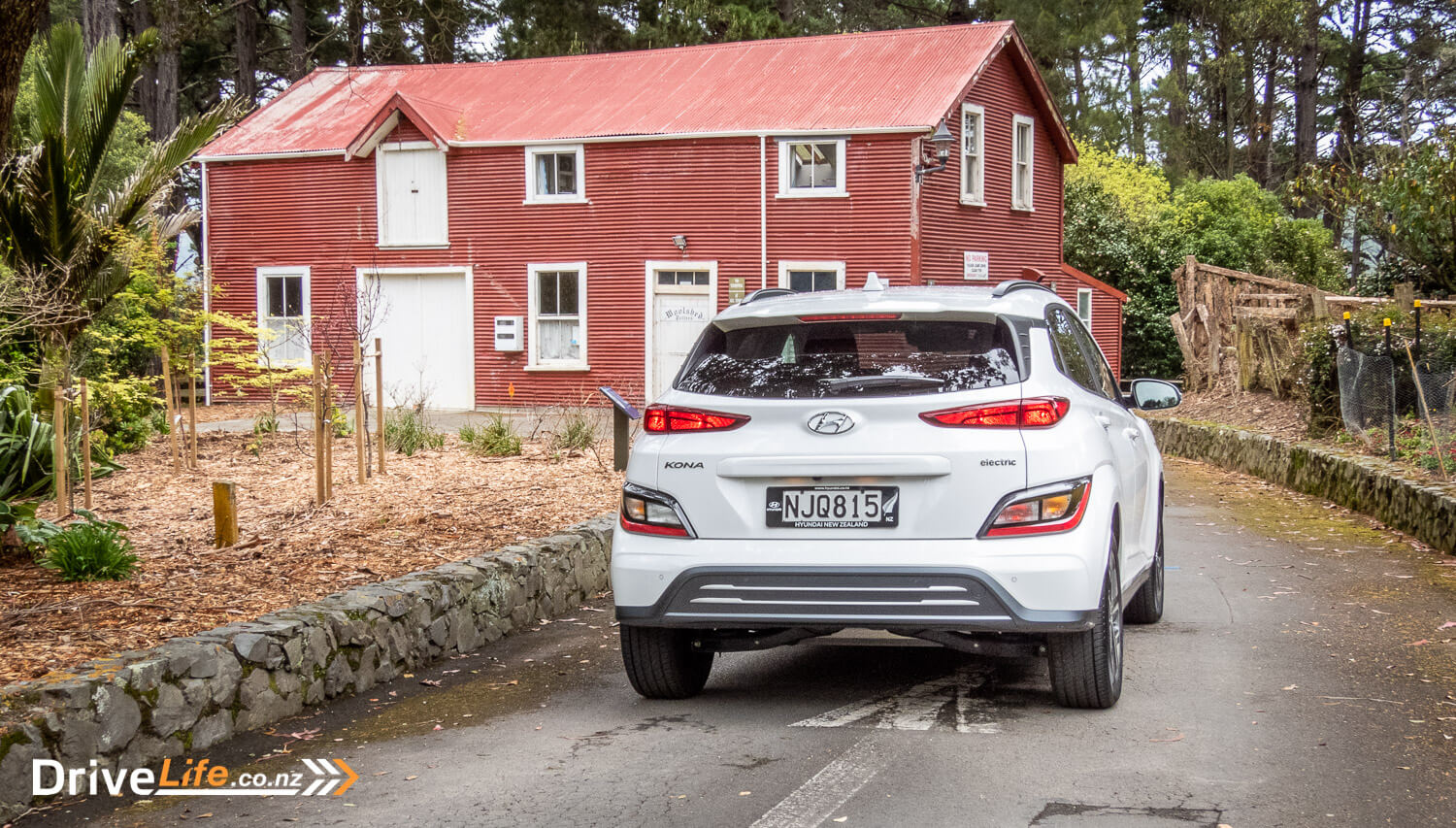
How Does The 2021 Hyundai Kona EV Compare To Its Competition?
| Make/Model | Battery Capacity kW/h | Power kW/Nm | 0-100km/h | Range (WLTP) | Boot Space | Price |
| Hyundai Ioniq 5 2WD | 72 | 160/350 | N/A | 481 km | 537 Litres | $89,990 |
| Mercedes-Benz EQA | 66.5 | 140/375 | 8.9 | 480 km | 340 Litres | $85,500 |
| Tesla Model 3 Long Range | 75 | 324/493 | 4.4 | 649 km | 561 Litres | $82,900 |
| Hyundai Kona 64kWh | 64 | 150/395 | 7.6 | 484 km | 332 Litres | $79,990 |
| Hyundai Ioniq 5 2WD | 58 | 125/350 | N/A | 384 km | 537 Litres | $79,990 |
| Mazda MX-30 | 35.5 | 107/271 | 9.7 | 224 km | 341 Litres | $74,990 |
| Tesla Model 3 Standard | 54 | 190/450 | 6.1 | 491 km | 561 Litres | $66,900 |
| Hyundai Kona 39kWh | 39.2 | 100/395 | <10 | 305 km | 332 Litres | $69,990 |
| Hyundai Ioniq | 38.3 | 100/395 | 9.7 | 311 km | 350 Litres | $65,990 |
| Peugeot 208 EV | 50 | 100/260 | 8.3 | 348 km | 311 Litres | $61,990 |
| Mini Cooper EV | 32.6 | 135/270 | 7.3 | 233 km | 211 Litres | $60,400 |
| MG ZS EV | 44 | 105/353 | 8.2 | 263 km | 359 Litres | $48,990 |
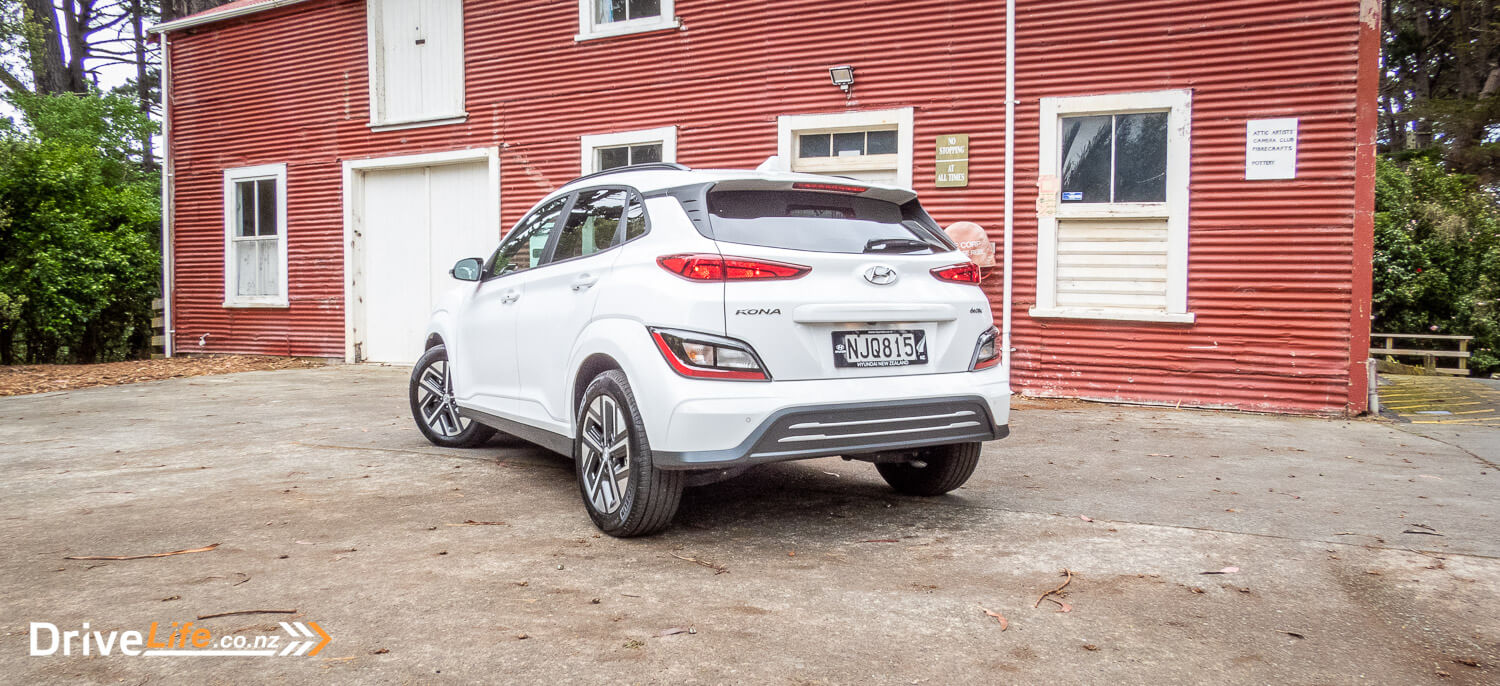
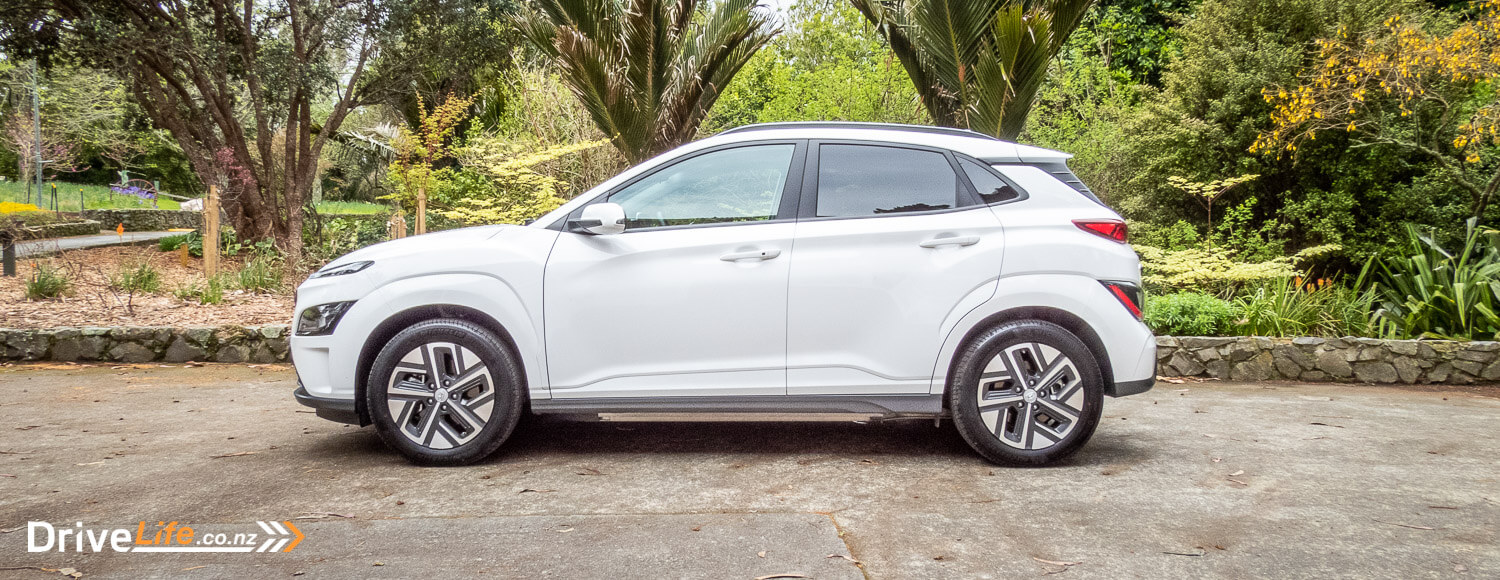
First Impressions Of The 2021 Hyundai Kona EV
The Hyundai Kona has always stood out in the small crossover class. The Kona is different, but in a somewhat conventional way. It’s as if the designers were granted a creative licence to make something that would stand-out, but nothing that would upset the shareholders.
There’s plenty going on up the front-end, but overall, their risks have largely paid off. That said, my opinion of the Kona EV II is divided.
Let’s start with the colour: White. It’s a tad kitchen appliance in it’s appearance. So, this wouldn’t be my immediate choice.
But the weirdest part is the lack of a nose, or should I say, the lack of a grille. To be fair, EV’s generally don’t have a grille. Manufacturers will often sculpt one in, or provide a ‘shield’ instead of a grille. The first Kona EV we tested had this treatment, but the Kona EV II has dropped it altogether.
Its absence is noteworthy and a departure from the usual ‘face’ we see on vehicles. I’m just gonna put it out there; the front-end of the Hyundai Kona EV II reminds me of a certain Harry Potter villain. I needn’t say which.
Overall, I wouldn’t call the EV the looker of the range, but it still carries some of the family’s genes.
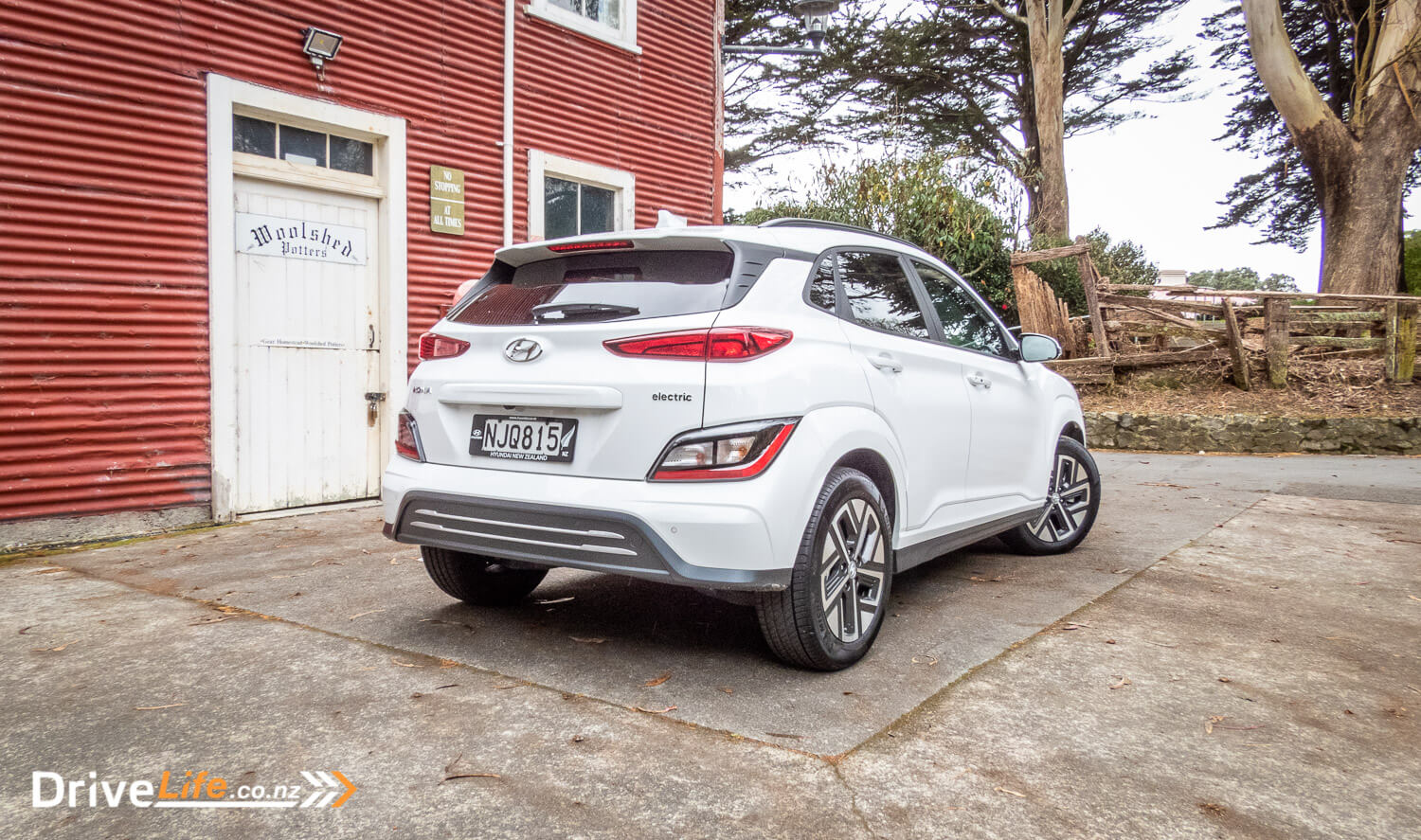
What’s The Interior Like In The 2021 Hyundai Kona EV?
The inside of the Kona EV is nowhere near as daring as the outside. The design is restrained – so restrained, that unfortunately, I cannot seem to shake this lingering kitchen appliance vibe.
The inside trims are a sea of shades – grey, darker greys, black. It’s the sort of colour palette you would find in an actuary’s wardrobe.
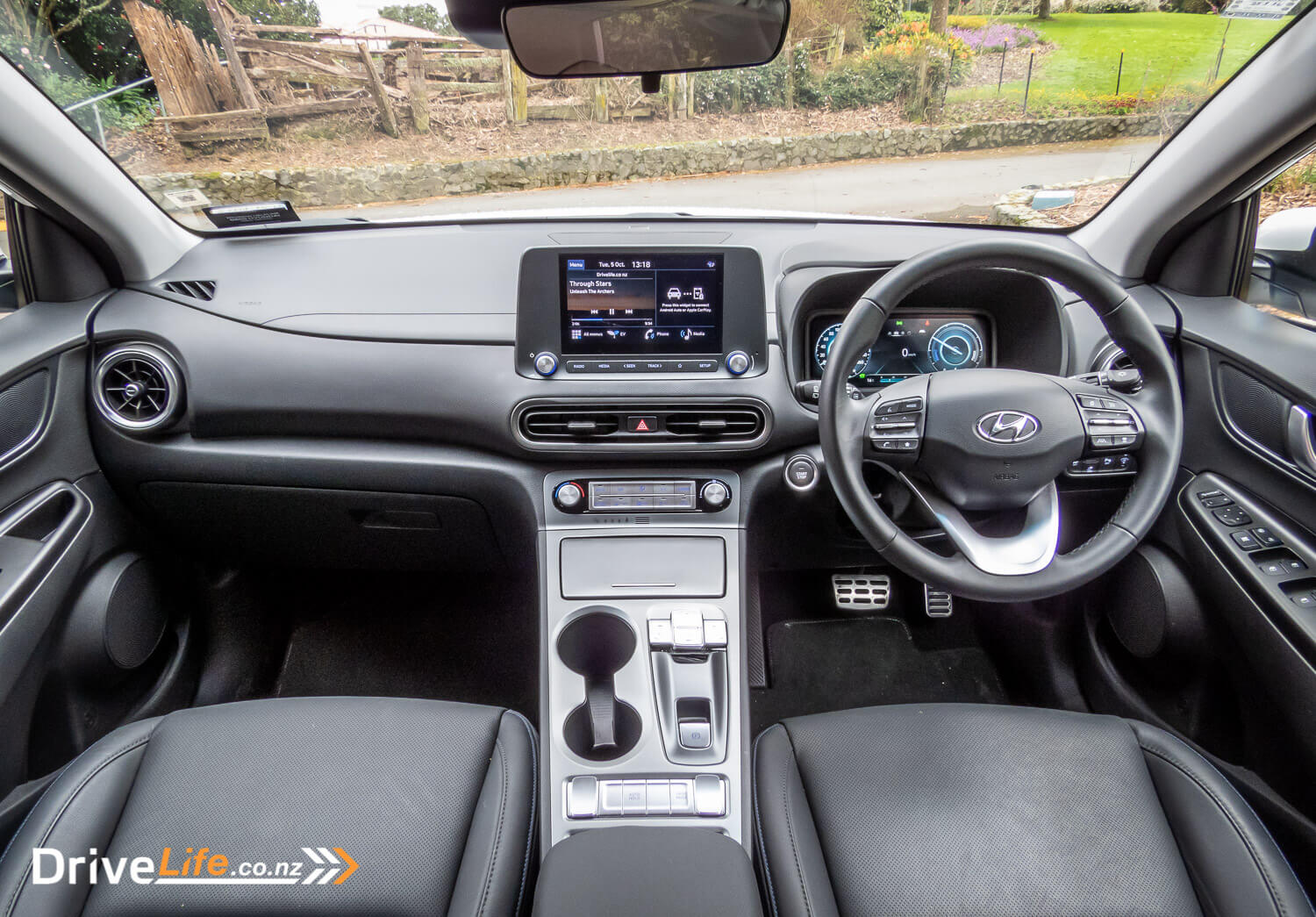
That said, even the most hardcore accountants have one wacky tie. That’d probably explain the contrast blue-stitching that Hyundai has added to leather seats to provide a bit of a visual lift.
Aside from a few unexciting colour choices, the interior is rather pleasant once you’ve actually settled in. Although it’s quite different on the inside to its petrol-powered Kona brothers, the EV didn’t feel too different from a relatively conventional, yet well-designed small crossover. Anyone, of any age group, could easily jump into a Kona and figure it out, which can’t be said for plenty of other EVs.
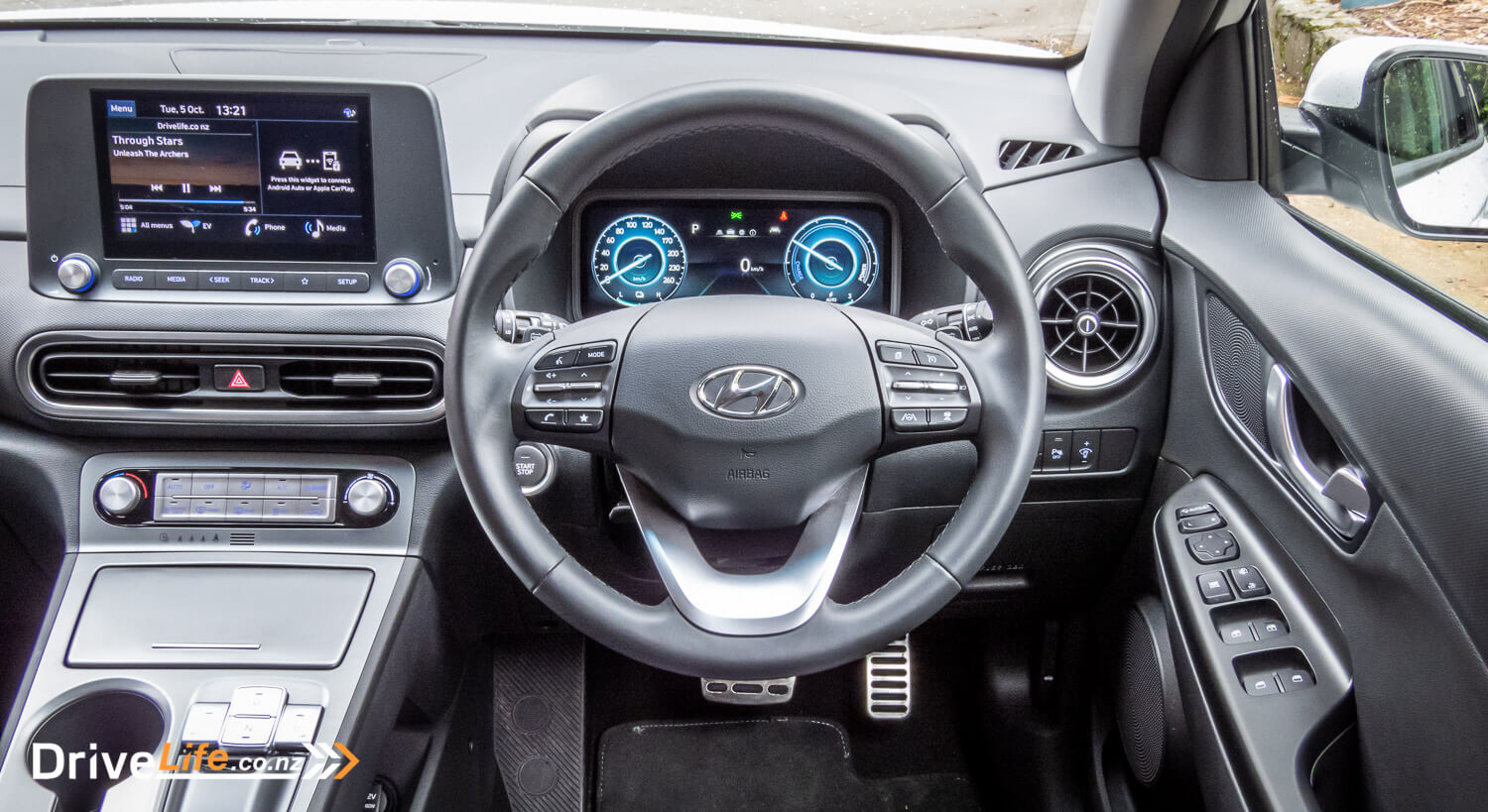
Ergonomically, everything felt great. The driving position was well set-up, with good forward and all-round visibility. The cabin had a pleasant airiness and was well-lit during daylight, meaning it felt more spacious inside the cabin. All the controls were within easy reach, plus the high-mounted bridge centre console meant that your arm rested at a comfortable height.
There’s also plenty of useful interior storage, with a large open space underneath the centre console, a moderately sized centre bin, plus decently sized door bins. Importantly, there’s also a dedicated space for your smartphone in the centre console, which is where the wireless charger would be on the Elite.
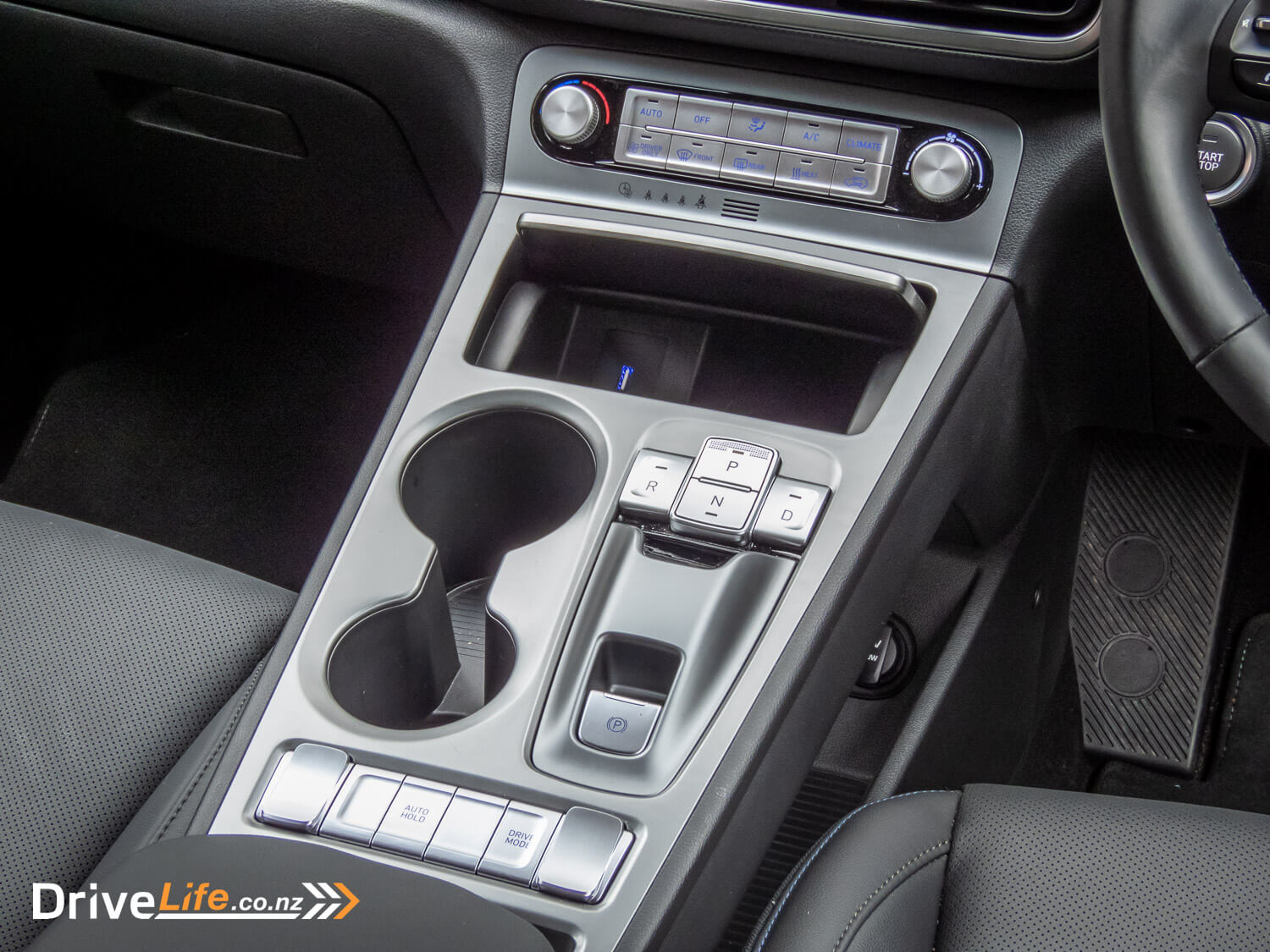
This brings us across to another negative point we covered off earlier in the article, and that’s regarding standard equipment. Hyundai is really cutting it short on toys with the base Kona relative to the Elite model. That said, this shouldn’t be immediately obvious to any passengers, unless they’re attentive to the blank switches dotted around the cabin.
Tacked-on front and centre is an 8-inch infotainment unit. By itself, this infotainment unit is a decent performer. Although it’s one of Hyundai’s older infotainment offerings, the interface is quite easy to learn and use, plus its responsiveness is reasonably good.
However, it’s a considerable step-down from Hyundai’s newest system, which is the 10.25-inch infotainment unit found in the Kona EV Elite. The 10.25’’ is the more modern of the two, boasting much sharper resolution, better colour and black levels, plus a fresher interface. Responsiveness is also improved over the older unit.
To put it another way, if the 10.25-inch is the latest iPhone, the 8-inch system is more like old Huawei. Hence, Hyundai tends to reserve the older unit for the cheaper models in its line-up. Sadly, the Kona EV isn’t exactly cheap, so it’s somewhat disappointing that it didn’t gain the best Hyundai has to offer.
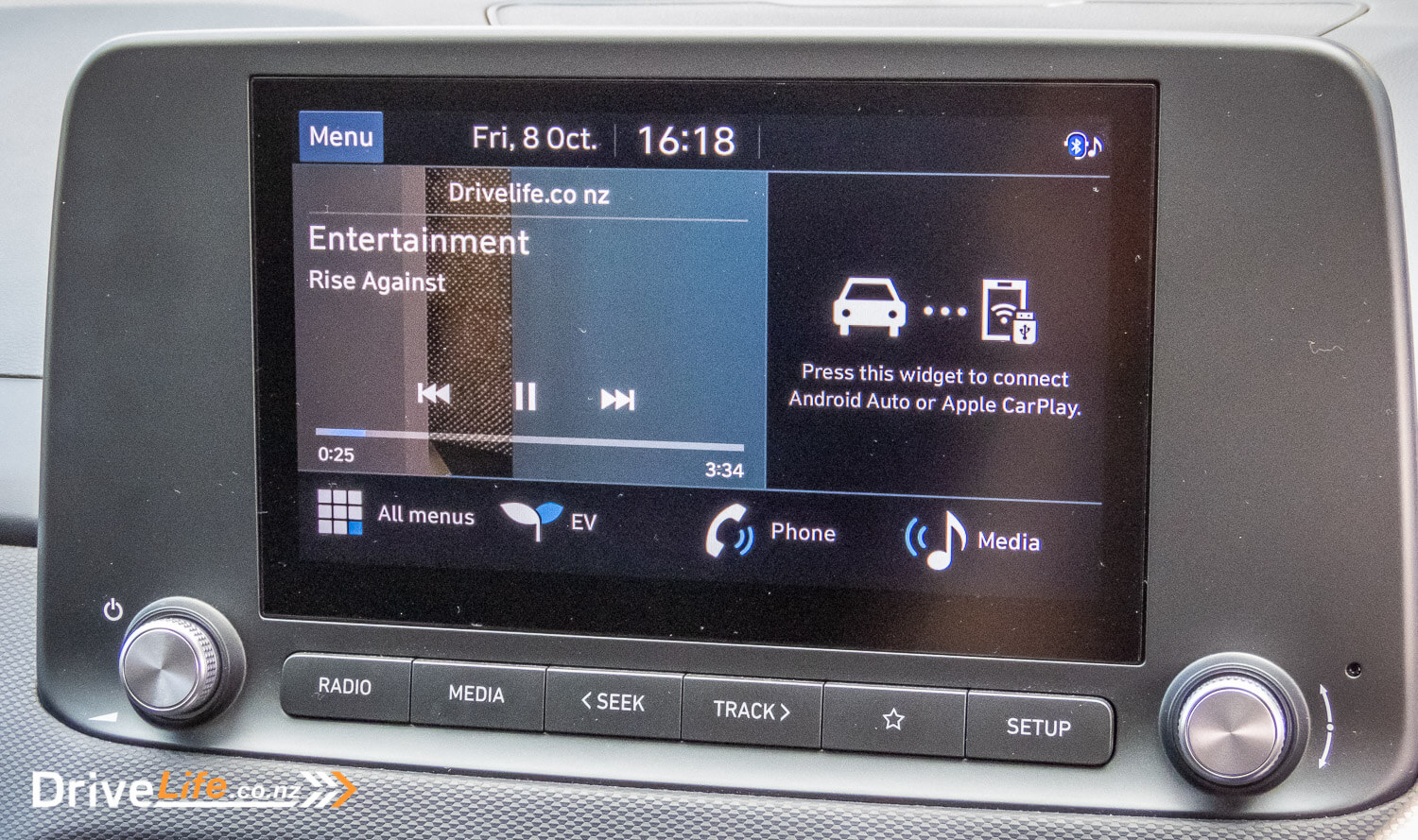
Where both trims of Kona are equal is with the fresh digital dash cluster, which is similar to others offered in Hyundai’s line-up. This cluster has great resolution, is very legible and responds rapidly. If there’s anything to dislike, it would be a lack of personal configurability. In reality, the lack of configurability didn’t bother me in the slightest. It’s also quite cool seeing the dial graphics change depending on the driving mode.
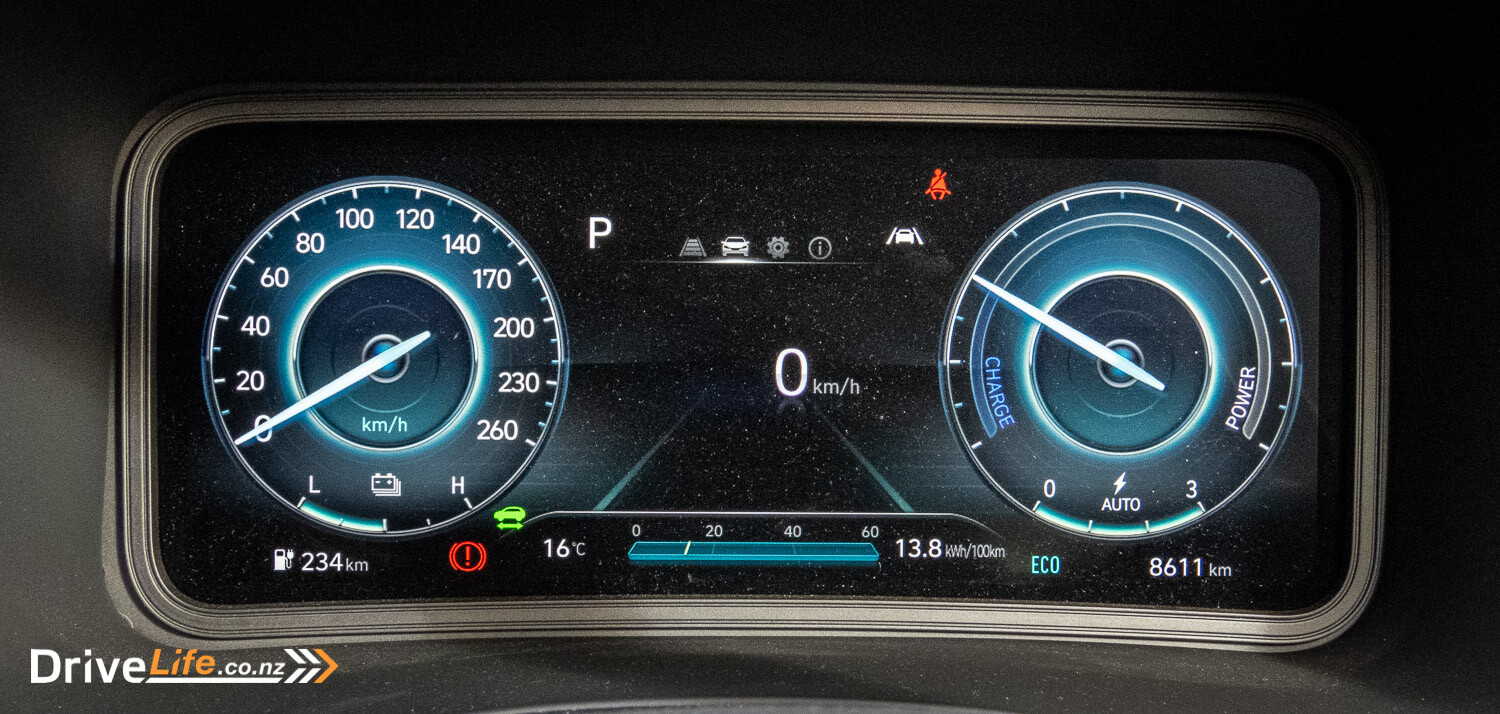
Although the base Kona EV misses out on the Harmon Kardon system of the Elite, the basic 6-speaker system is actually quite good. The sound is well balanced, with no major flaws making themselves known.
As we’d commented earlier, the front seats are the spot to be in the Kona. There’s a good driving position, good ergonomics, and good forward visibility. I found the seats themselves to be reasonably comfortable, despite their lack of configurability.
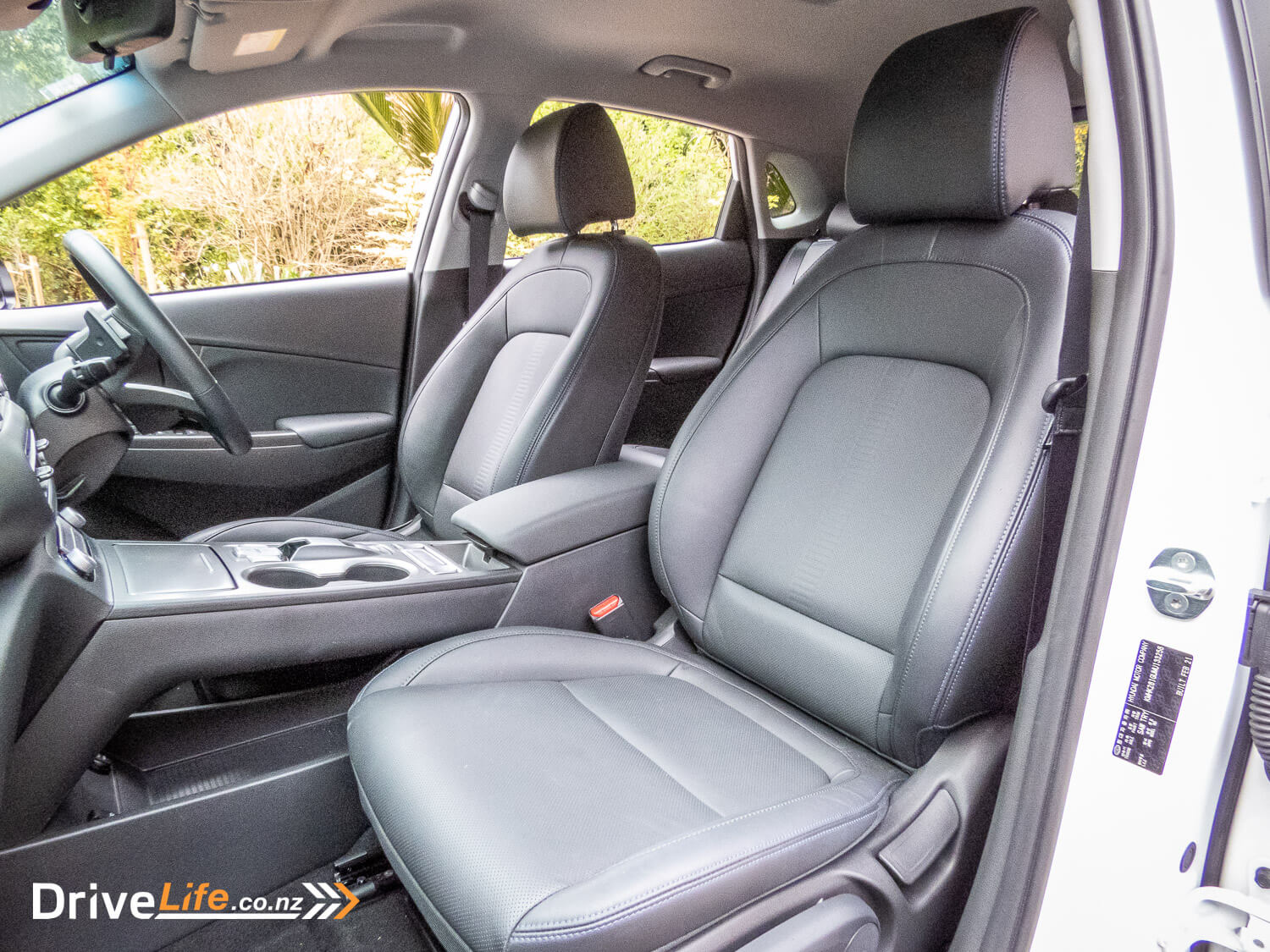
Where you’ll begin to notice the Kona’s small SUV dimensions is in the back, where the rear seating isn’t exactly generous. Although there’s plenty of headroom available, most adults will find their legs pushed up against the front seats. The EV battery also seems to create a higher floor, which means your thighs will likely be lifted off the seat from their natural resting position.
At 332 litres, the boot isn’t exactly humongous either. But the crossover SUV shape means you can make proper use of all 332 litres. Drop the rear seats, and you’ll get a more cavernous 1,114 litres of space.
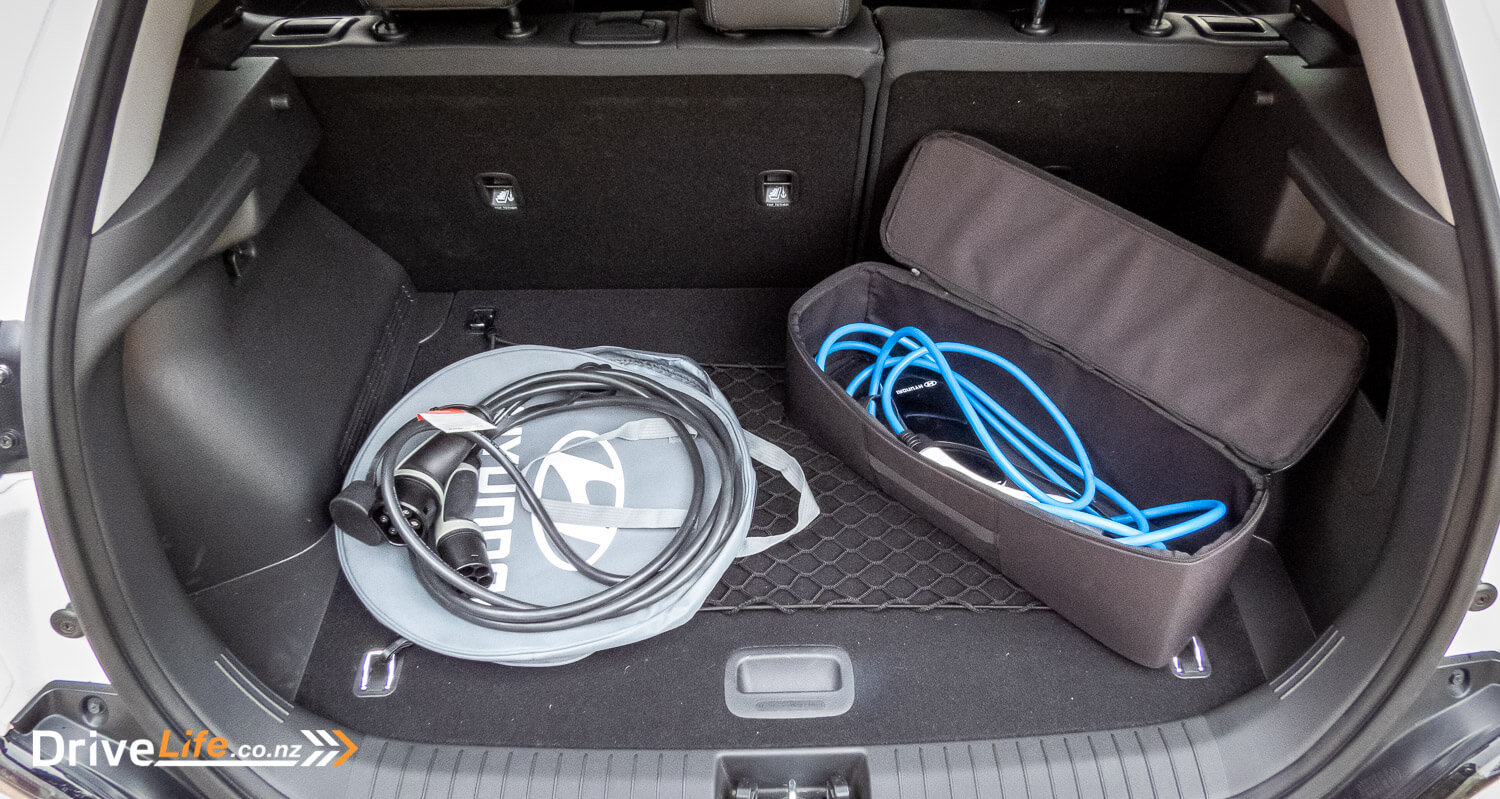
Overall, the Kona EV offers a reasonably comfortable and functional interior, even if the base model is a bit no-frills. Given that there’s a 6-grand difference between this and the Elite, I suspect many private buyers will be tempted to spec-up, and that this trim will be the preference of the fleet market.
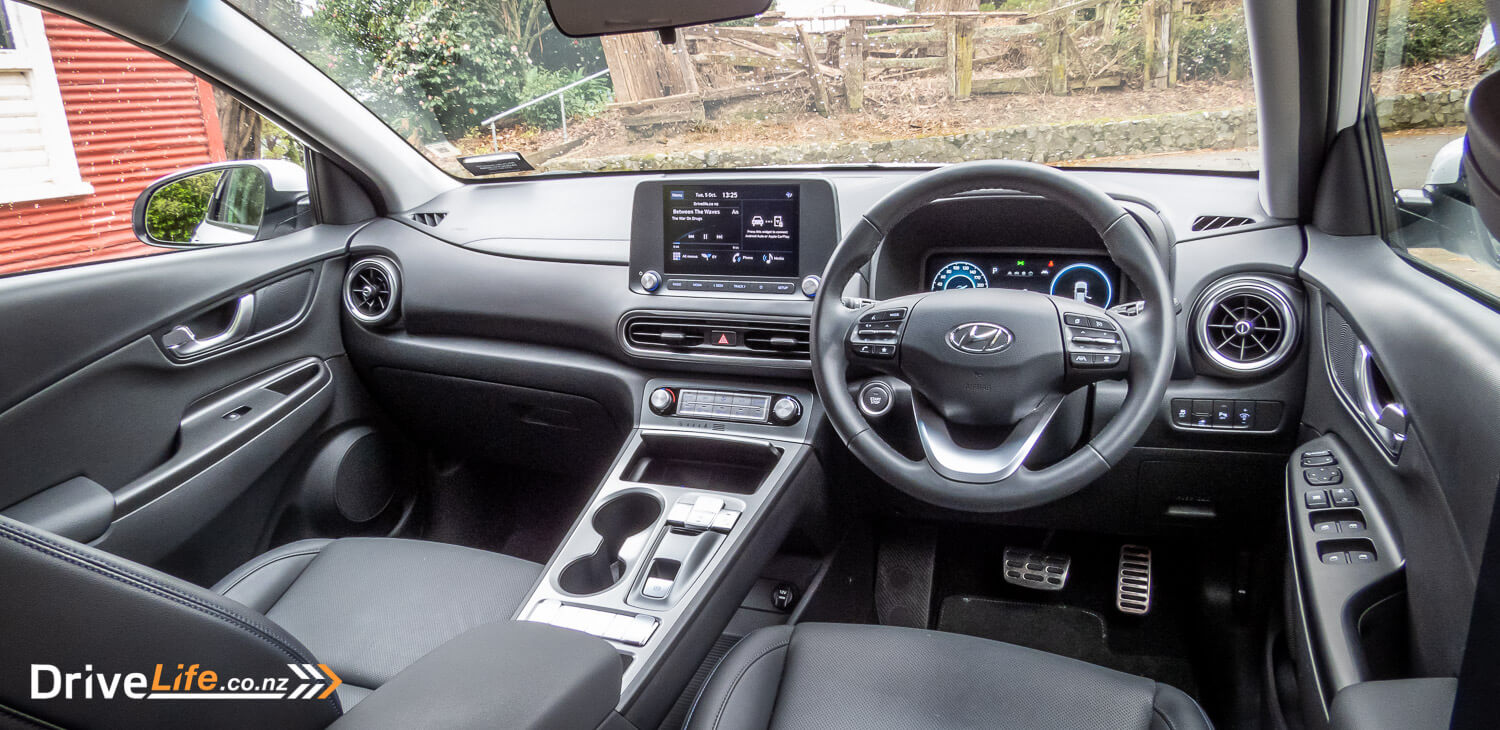
What’s The 2021 Hyundai Kona EV Like To Drive?
Since Fred first reviewed the Kona EV back in 2018, there hasn’t been a great deal of changes underneath. The drivetrain is the same, as is the battery capacity, yet somehow Hyundai managed to up the range to a claimed 484kms for the 2021 Kona EV from 449kms back in 2018.
So, what have Hyundai done to achieve this efficiency gain? The answer is tyres. For 2021, the Kona EV has switched to a Michelin Primacy 4 EV tyre, which is responsible for the majority of this efficiency gain.
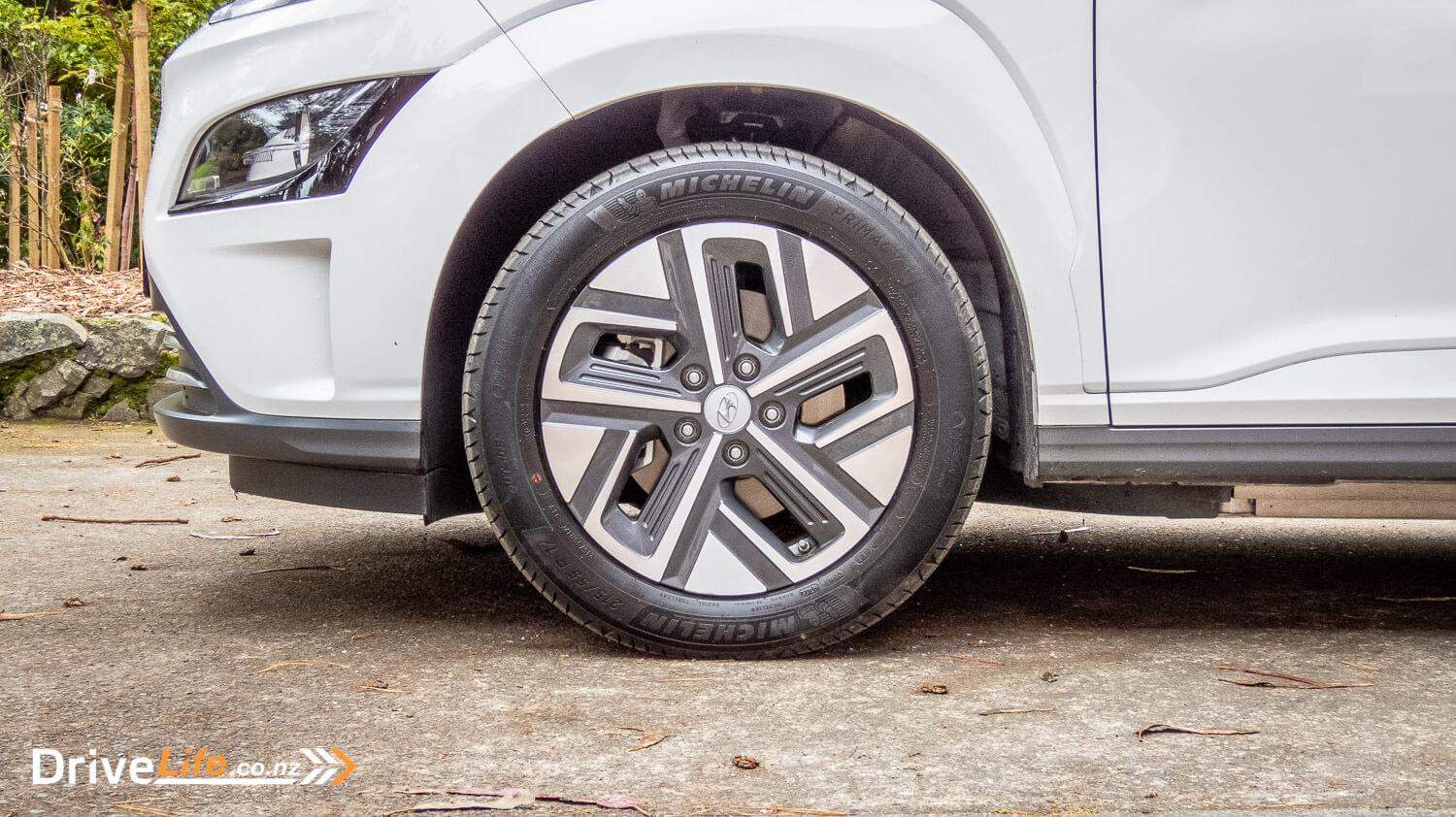
EV tyres are constructed differently to the tyres an internal combustion vehicle would usually wear. They’re designed to be effective for an EV, to optimise their efficiency. EV tyres are also generally stiffer to account for the weight of the vehicle and have fewer grooves in the tyre too. They also tend to have some extra insulation to help dull road noise, which is essentially the only thing you hear in an EV.
I’ll cap it there, because this isn’t a tyre review. The point is that it improves energy efficiency. This brings us to our first observation – Hyundai’s EV’s are excellent with their energy efficiency.
Energy efficiency is a common factor overlooked by many when considering an EV. Most will pay attention to the range without considering energy consumption, which is sort-of similar to only looking at the size of engine when buying a car, while ignoring fuel economy.
During our time with the Kona 64kWh EV, we achieved a consumption of 13.8kW/100kms, which is better than Hyundai’s own claimed figures of 14.7kW/100kms for this vehicle. This result is even more impressive when you consider how we were testing the vehicle. My commute is mostly on the motorway, where EV’s have a natural handicap relative to their petrol-powered brothers. I also wasn’t exactly trying to hyper-mile it either.
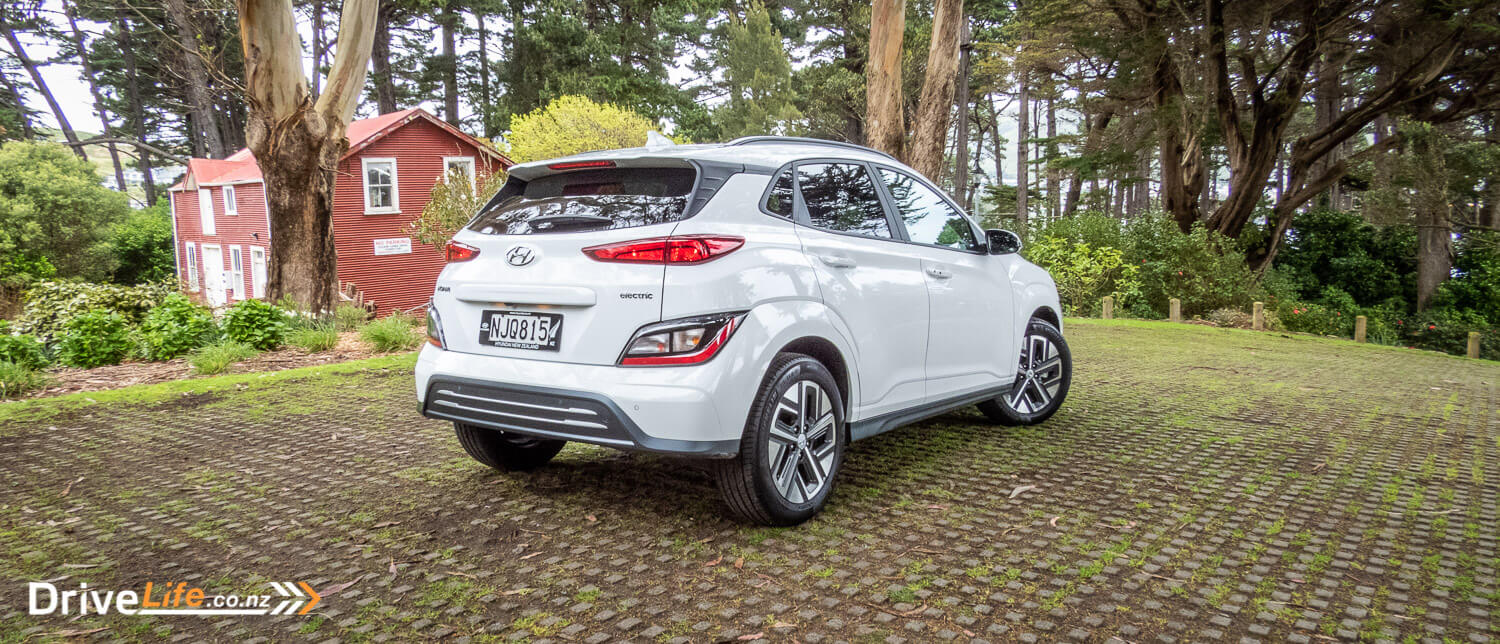
I did reset the gauge for a short jaunt around the streets of Wellington, and managed to push the range down to 12.6kWh/100kms. This better-than-expected energy consumption is like going more miles on a single tank of petrol, and at 12.6kWh, we’d have been able to squeeze more than 500kms of range out of the Kona!
Another impressive efficiency was with the climate controls. Running the A/C in an EV generally saps a bit of energy and therefore depletes your range. It’s a modern throwback to when you’d switch off the AC in a 1980’s car to get more gas mileage (some things don’t change).
However, not all EV’s are equal in this regard. I’ve been in a few EV where the range has shockingly dropped by around 30kms just to get some cool air.
So, how about the Kona then? When I first collected the car at full charge, I switched the AC. I lost only 1km! Of course, this isn’t always the case. The worst case I noted was the range dropping by about 11kms, but that’s still surprisingly efficient.
To sum it all up, if there was an EV equivalent phrase for “runs on the smell of an oily rag”, they’d be talking about the Kona EV!
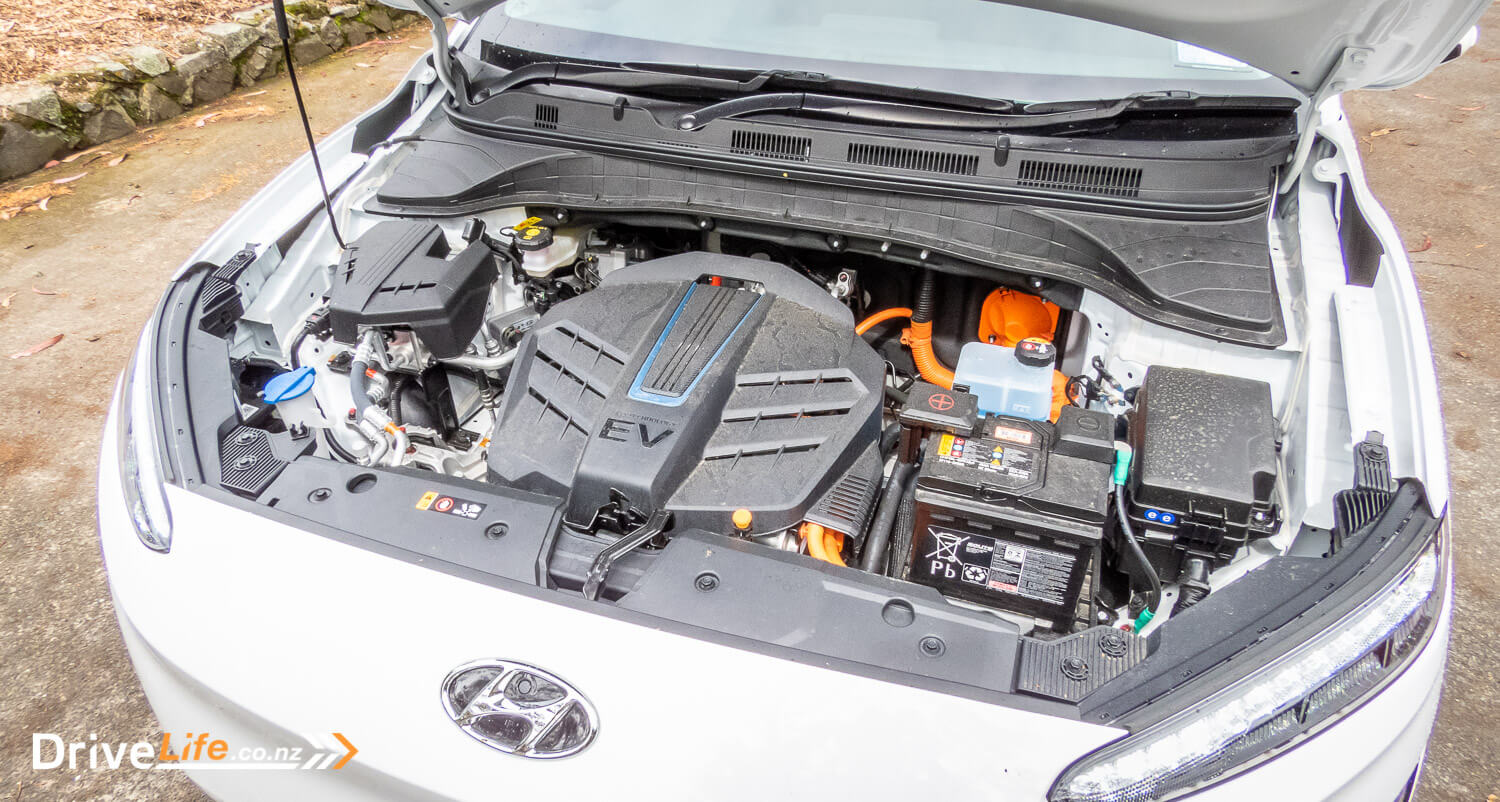
What about performance then? The Kona EV can displace itself rather briskly, with its electric motors and the 64kWh battery combo producing 150kW of power and 395Nm of torque. It will feel like a missile if you’ve come straight from the 2.0L petrol Kona.
If you do happen to stomp the accelerator, you will notice that the electric motors do produce noise when you initially set-off. I thoroughly appreciated this, as noise is going to be one of the biggest things I’ll miss as cars gradually electrify.
After stabbing the throttle, you’ll also notice the effectiveness of the regenerative braking too. There are three levels of re-gen offered in the Kona EV, plus an automatic mode, where the car decides what’s best. I did find that the car does bias itself towards the higher levels, which means you’ll be one pedal driving much of the time.
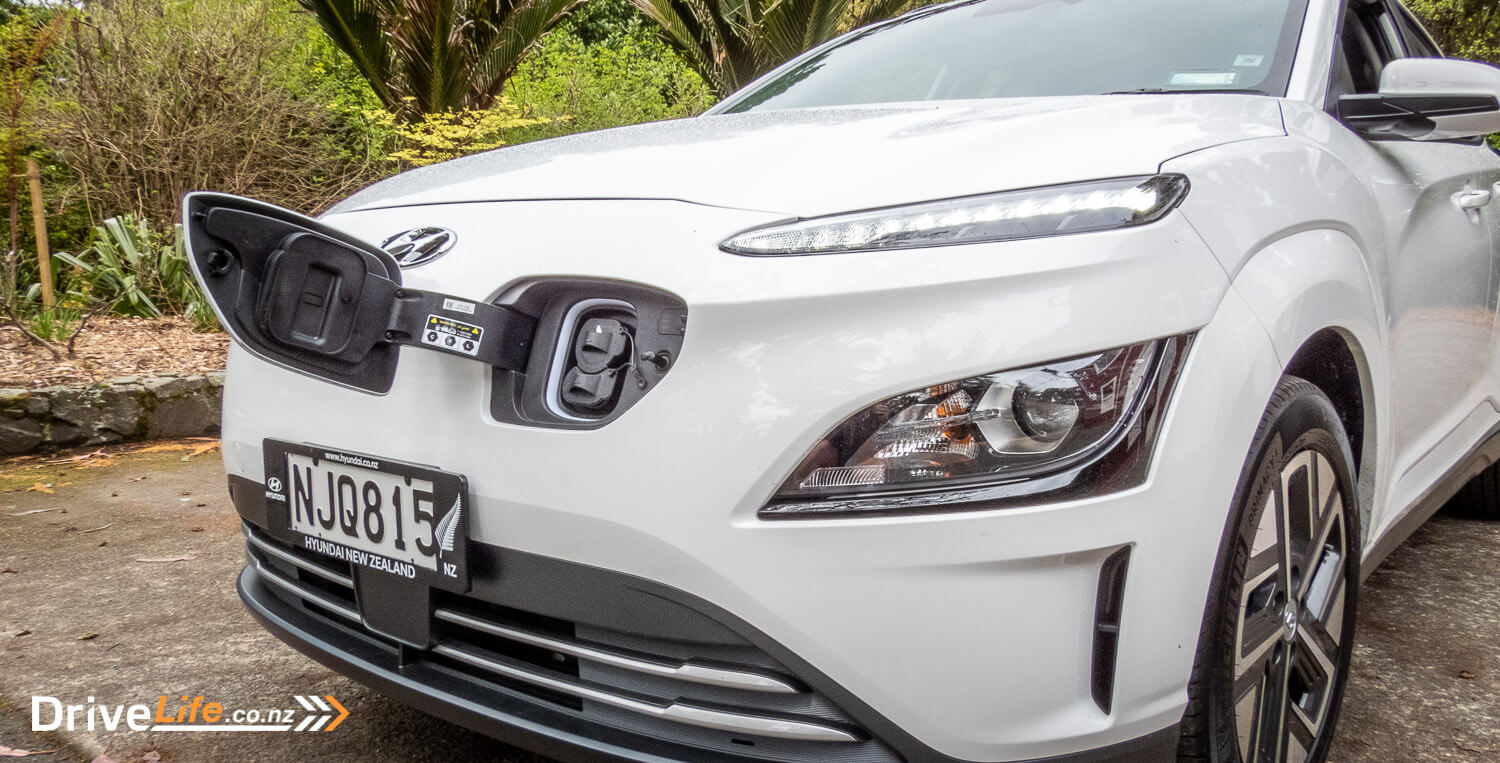
If you decide to switch the re-gen right down, you’re going to want to know if the Hyundai can hold its velocity through a corner. I’m happy to report that the answer is yes! The Kona handled well considering its crossover underpinnings and managed quicker corners with relatively little body roll. Sure, the Kona is no sports car, but its balance means you can have a wee bit of fun on a bend.
Of course, the suspension bias in this car is towards comfort, where the Kona does an impressive job. The Kona EV has good ride quality and is supple over harsher bumps, if a tad wallowy at times on the rebound.
As for vehicle technology, the safety items worked without a hiccup. The adaptive cruise control worked effectively down to a halt, with relatively smooth inputs. The lane keeping assistance was also well calibrated, which isn’t something Hyundai has always scored top marks on. Importantly, none of the Kona’s safety systems were overbearing, which is exactly what you want from a new car.
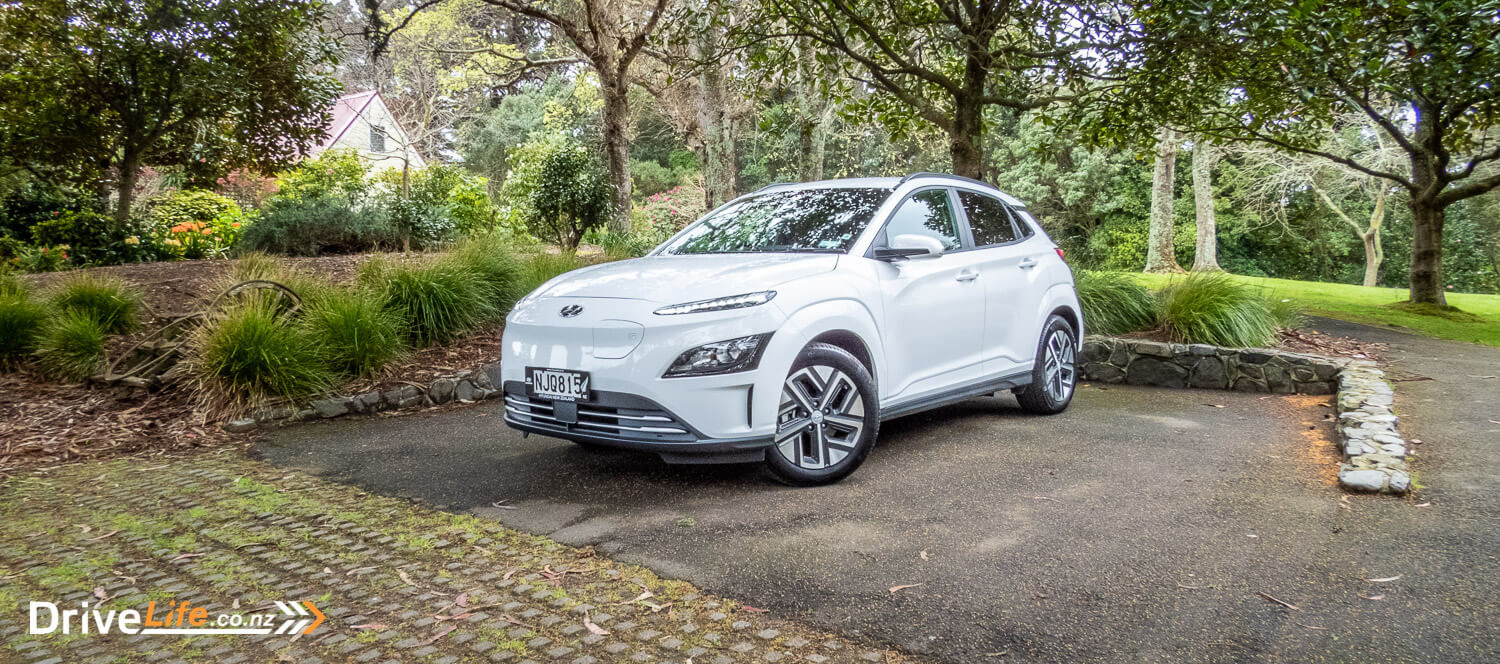
Up until this point, the Kona’s all-round performance left me rather impressed. However, the Kona EV does have an Achilles heel, and that’s the price.
Unfortunately, the Kona EV is a bit expensive in New Zealand’s market. Our Aussie mates get the Kona for a much cheaper base price, with 64kWh versions (they sell a different spec to us) sitting in the low $60,000 AUD range.
Sure, one could argue the Aussies pay more to register their cars and once you factor the exchange rate and New Zealand’s generous EV subsidy relative to Australia’s patchy EV policies (Australia’s EV subsidies vary state-to-state) the difference does start to narrow. But surely it should be cheaper, Hyundai? Perhaps this is a transitory issue, and it may change coming out of Covid? Who knows?
But right now, a standard range Tesla Model 3 with 491kms of range is cheaper than our base Kona EV. Heck, even a Mercedes EQA is cheaper than the most expensive Kona EV.
Suffice to say, the Kona might be a tough sell for some.
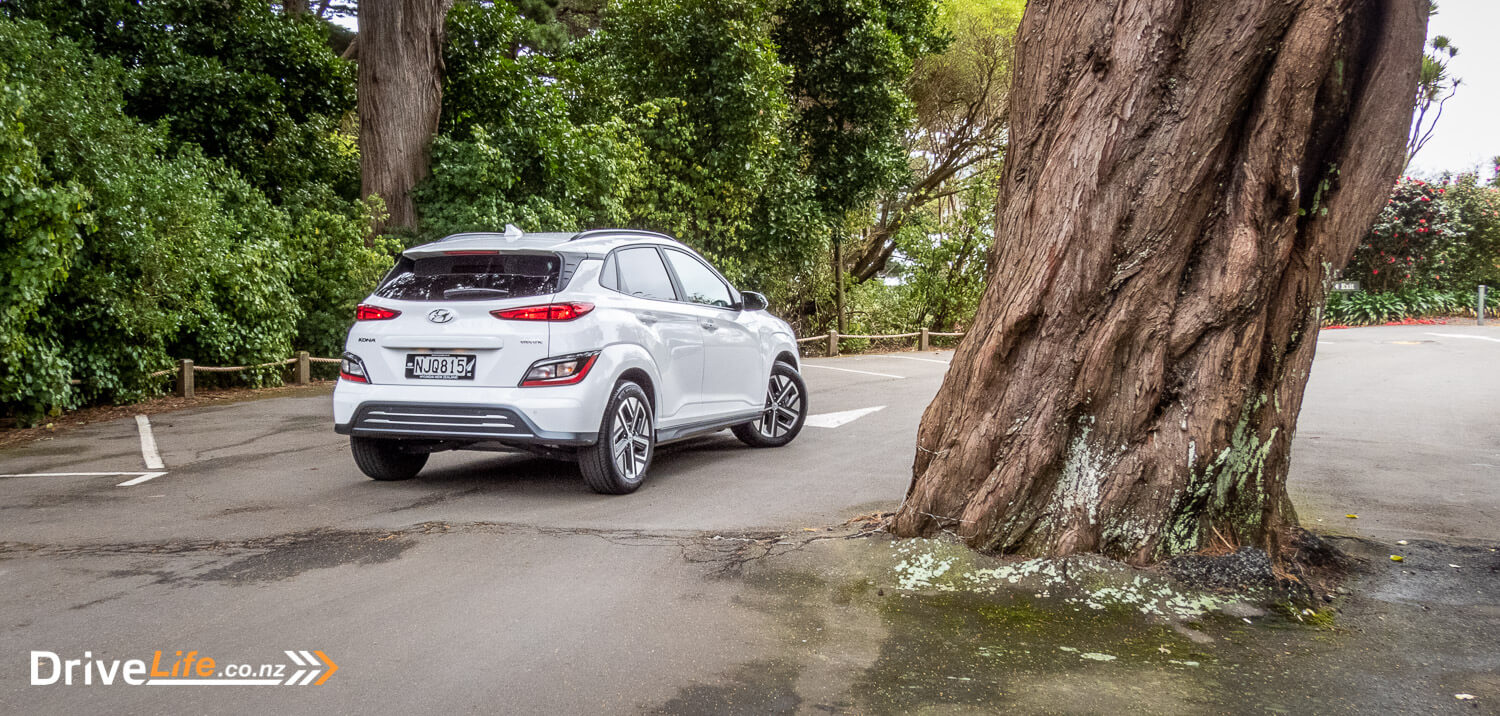
2021 Hyundai Kona EV Specifications
| Vehicle Type | Electric Crossover SUV |
| Starting Price | $79,990 |
| Price as Tested | $79,990 |
| Engine | Battery Electric Motor |
| Power, Torque kW/Nm | 150 / 395 |
| Transmission | Direct Drive System |
| Spare Wheel | N/A |
| Kerb Weight, Kg | 1,685 |
| Length x Width x Height, mm | 4205 x 1800 x 1570 |
| Cargo Capacity, litres | 332 |
| Range | 484km |
| Electric Economy, kWh/100 km | Advertised Spec – Combined – 13.8 Real-World Test – Combined – 14.7 |
| Towing Capacity Kg, unbraked/braked | N/A |
| Turning circle, metres | 10.4 Small: 6-10m / Medium 10-12m / Large 12m+ |
| Warranty | 3 year or 100,000km mechanical warranty 8 years or 160,000 km high-voltage battery warranty 10 year or 200,000km anti-corrosion warranty |
| Safety information | Ancap Rating – 5 Stars Rightcar.govt.nz – 5 Stars – NJQ815 |
